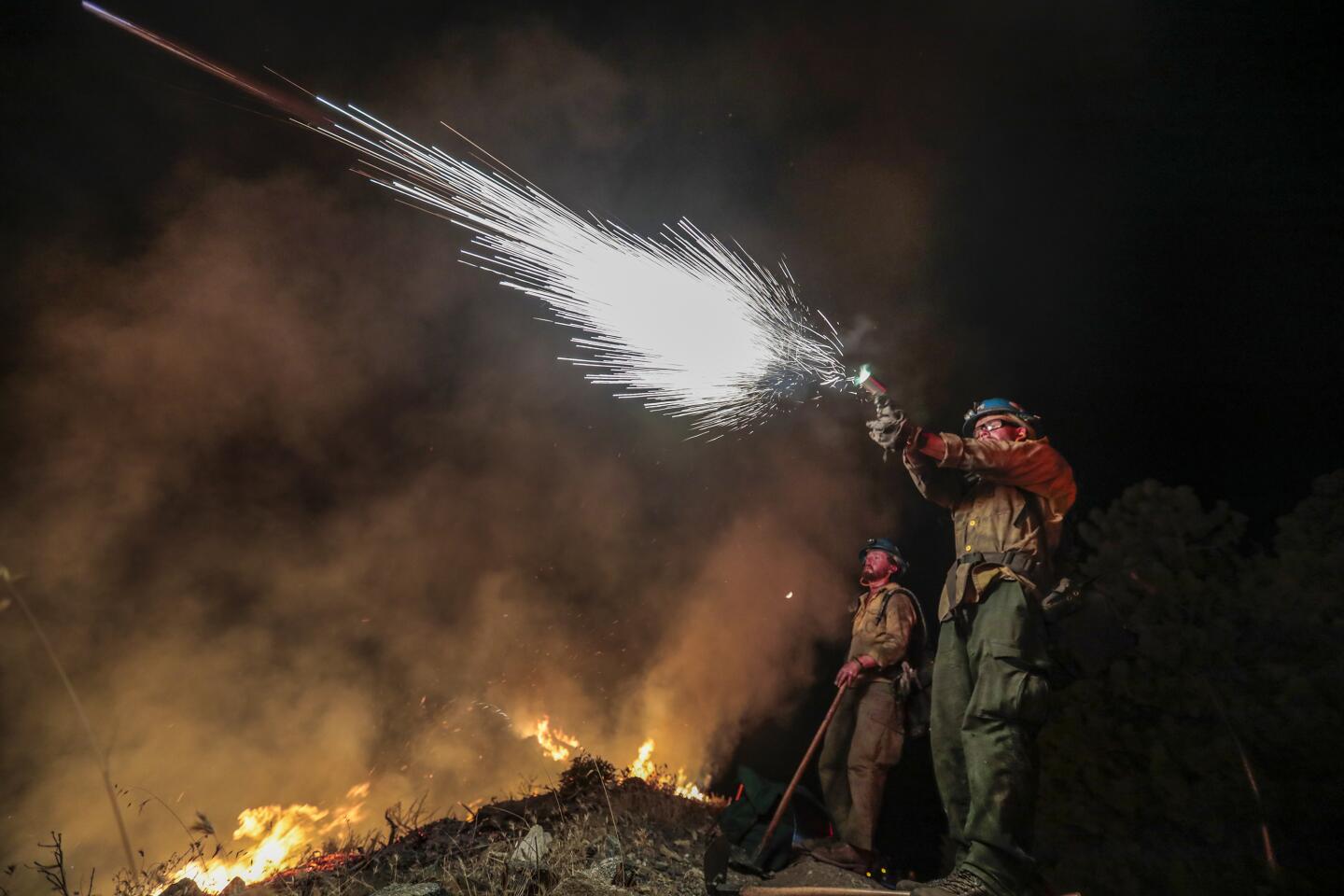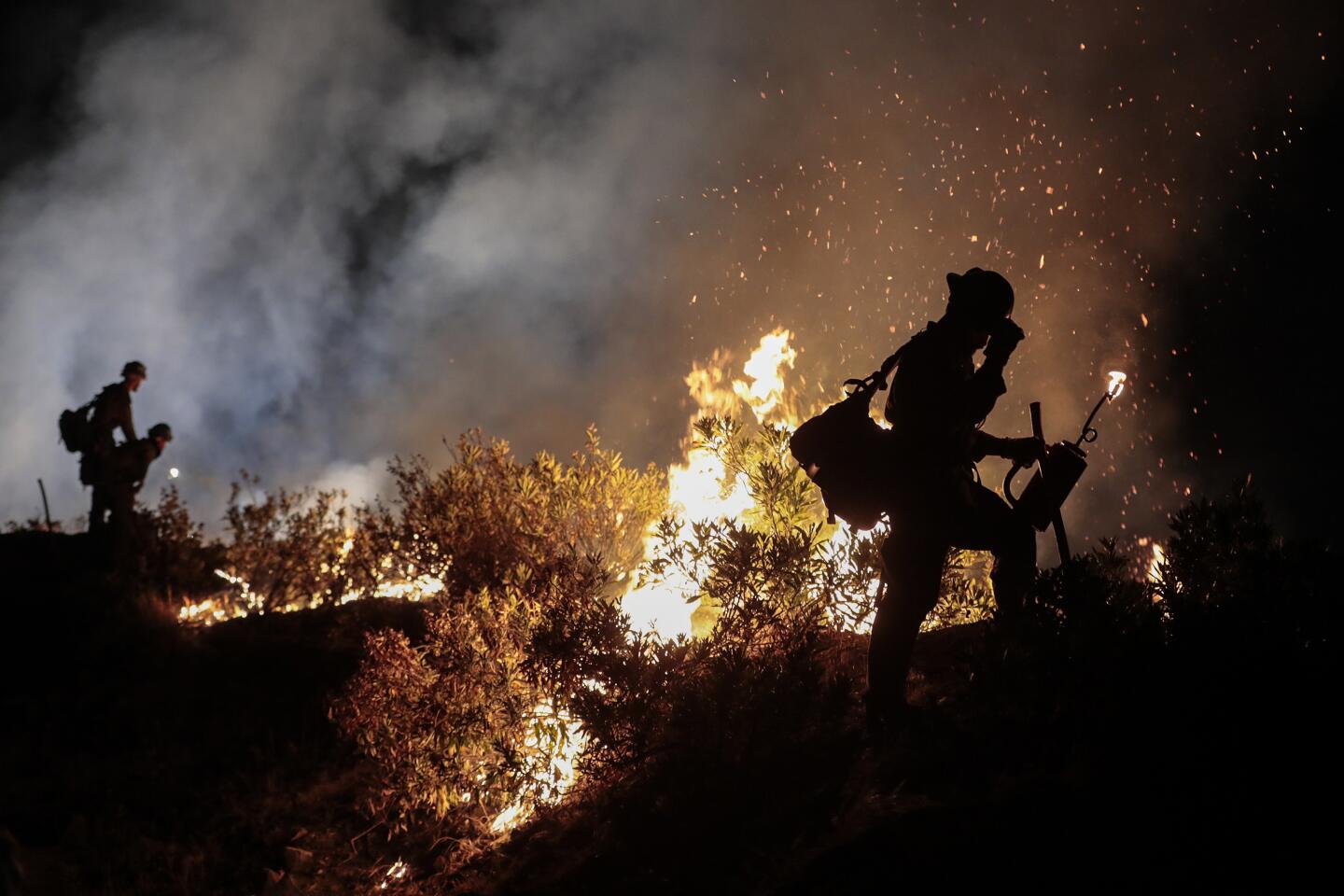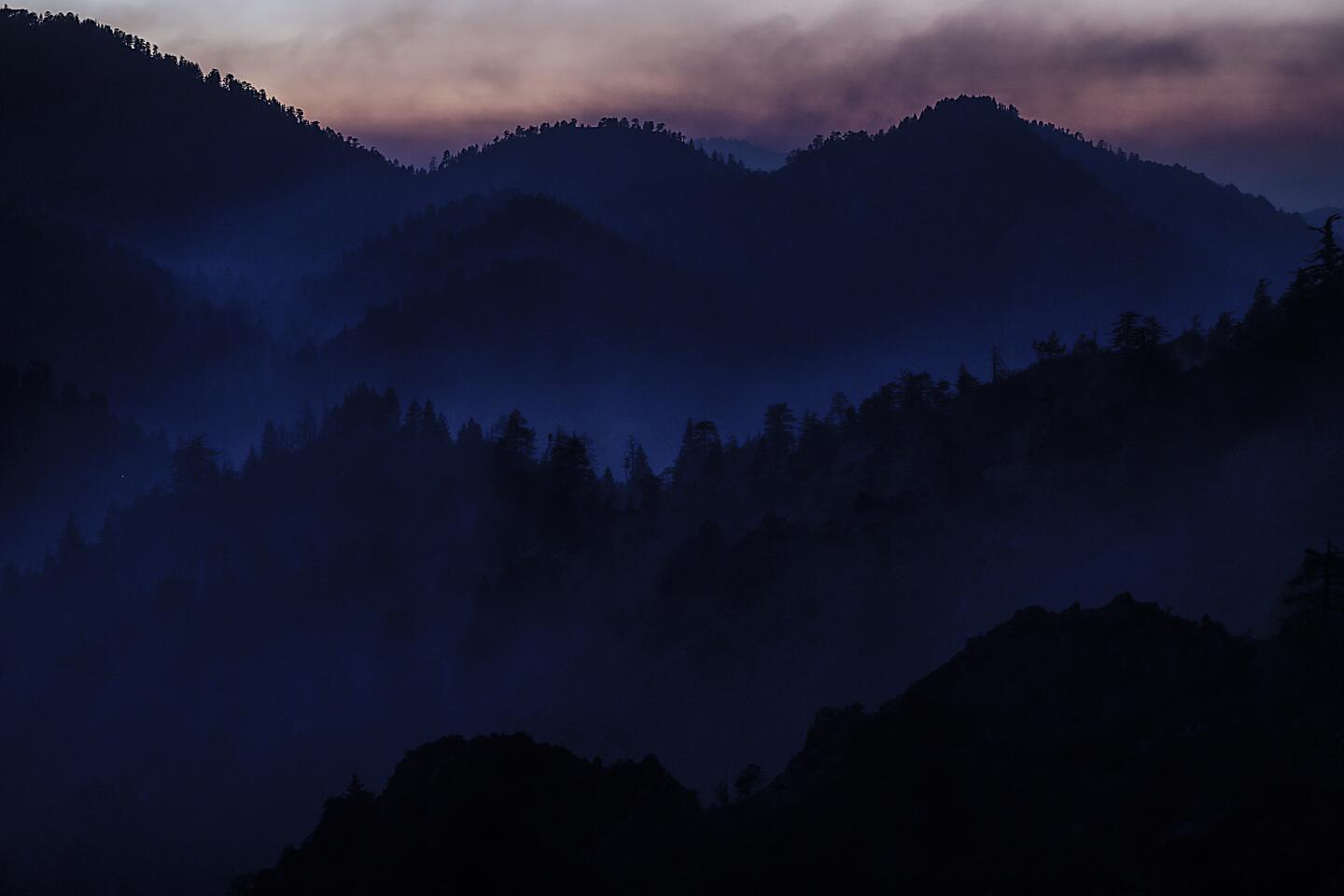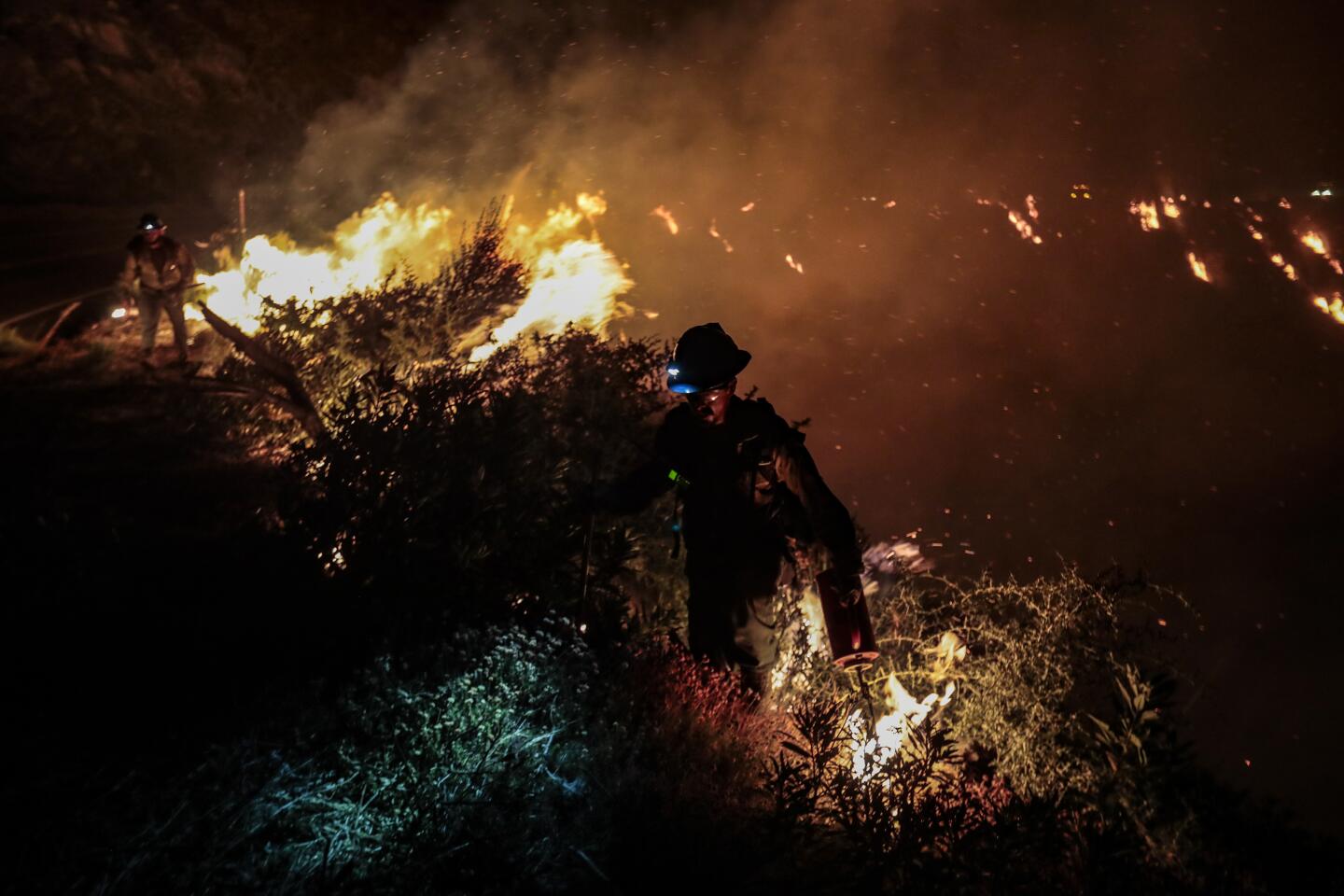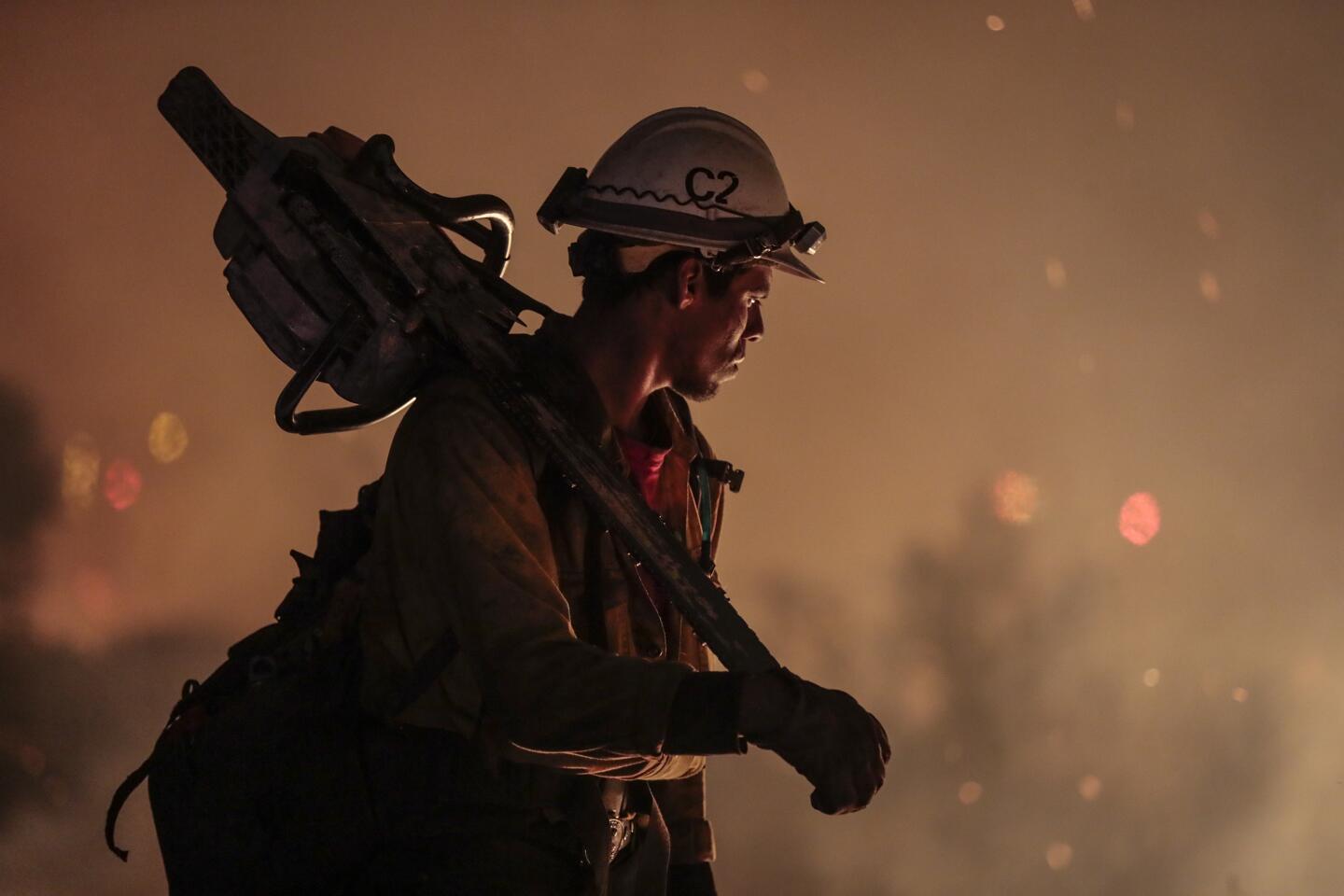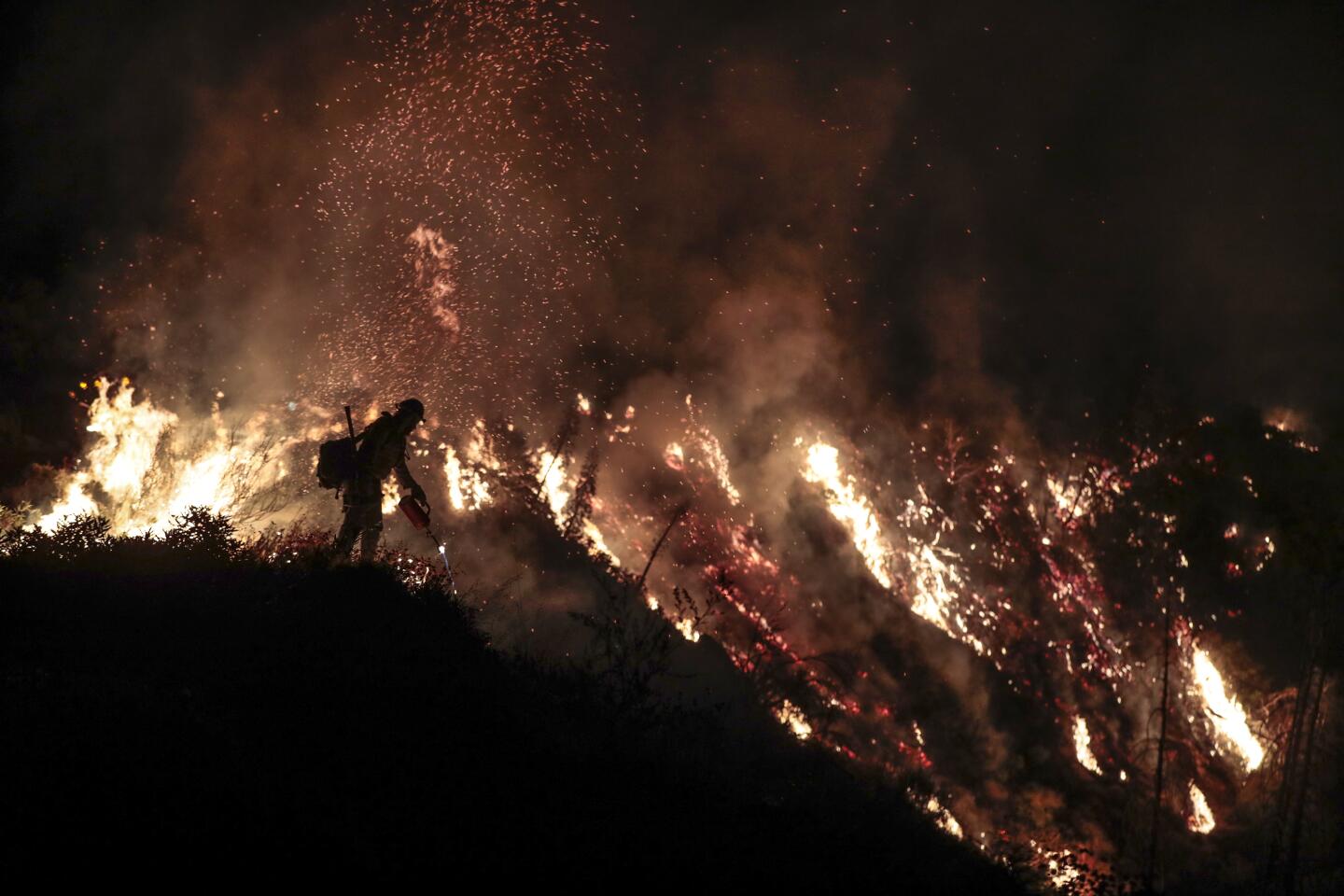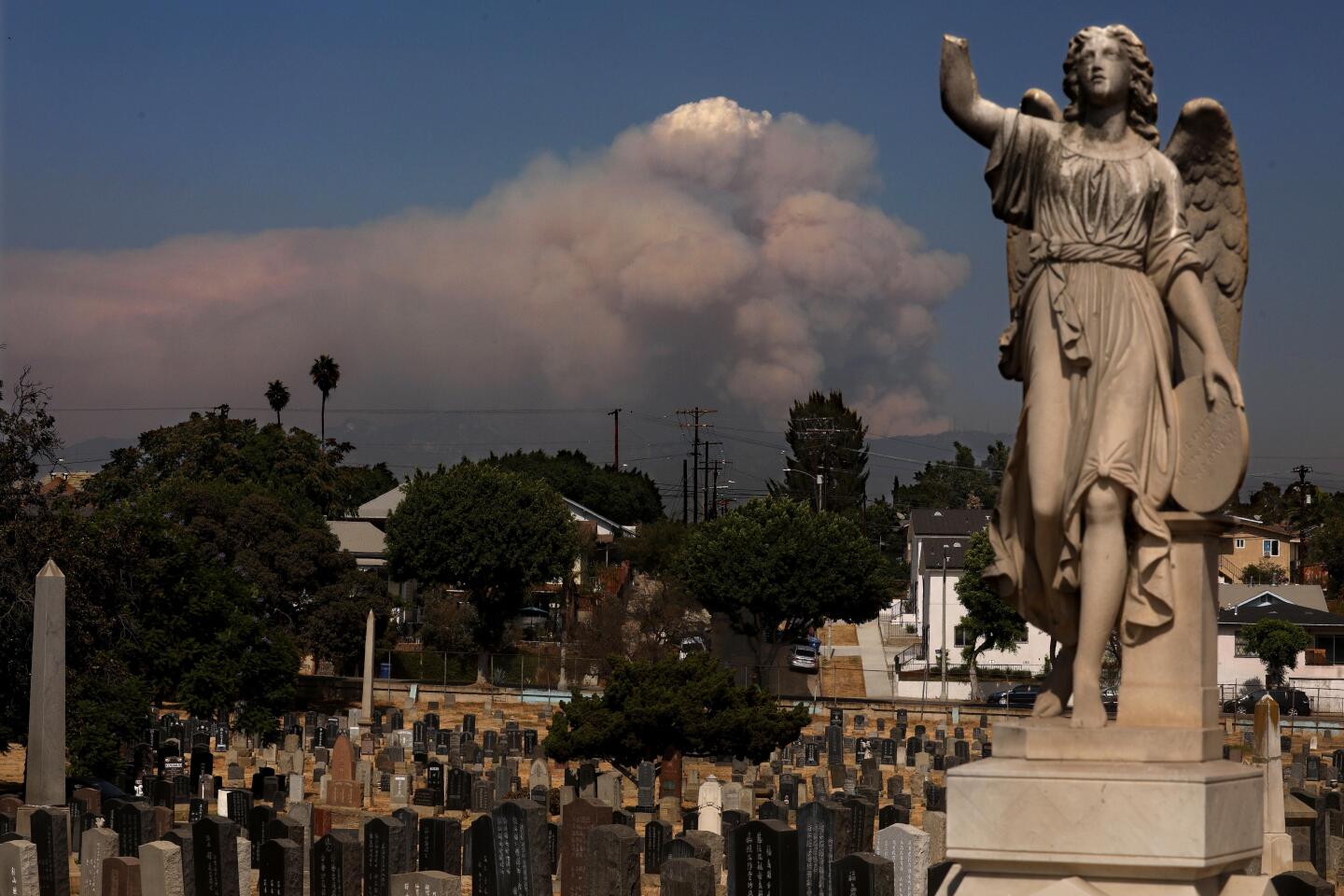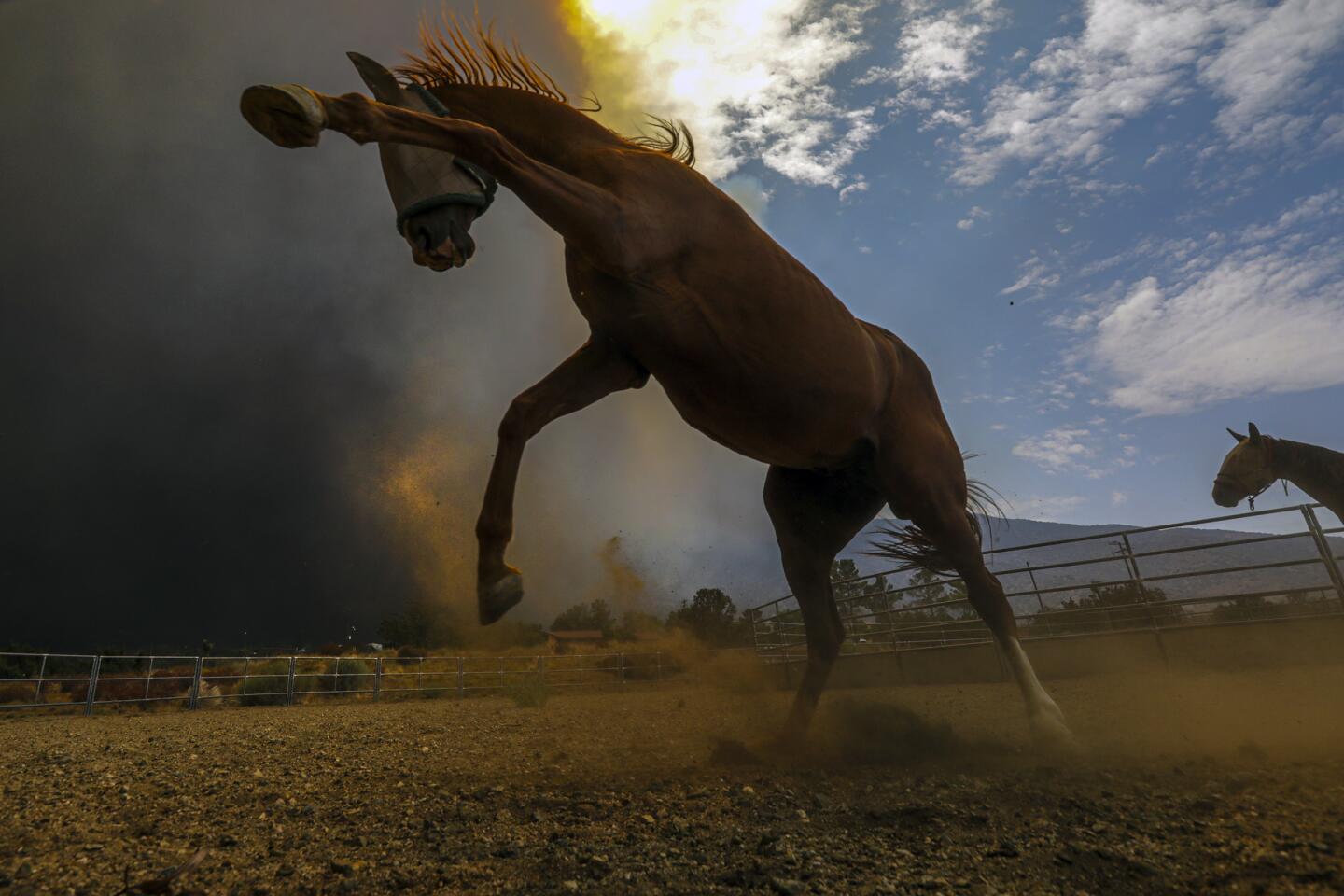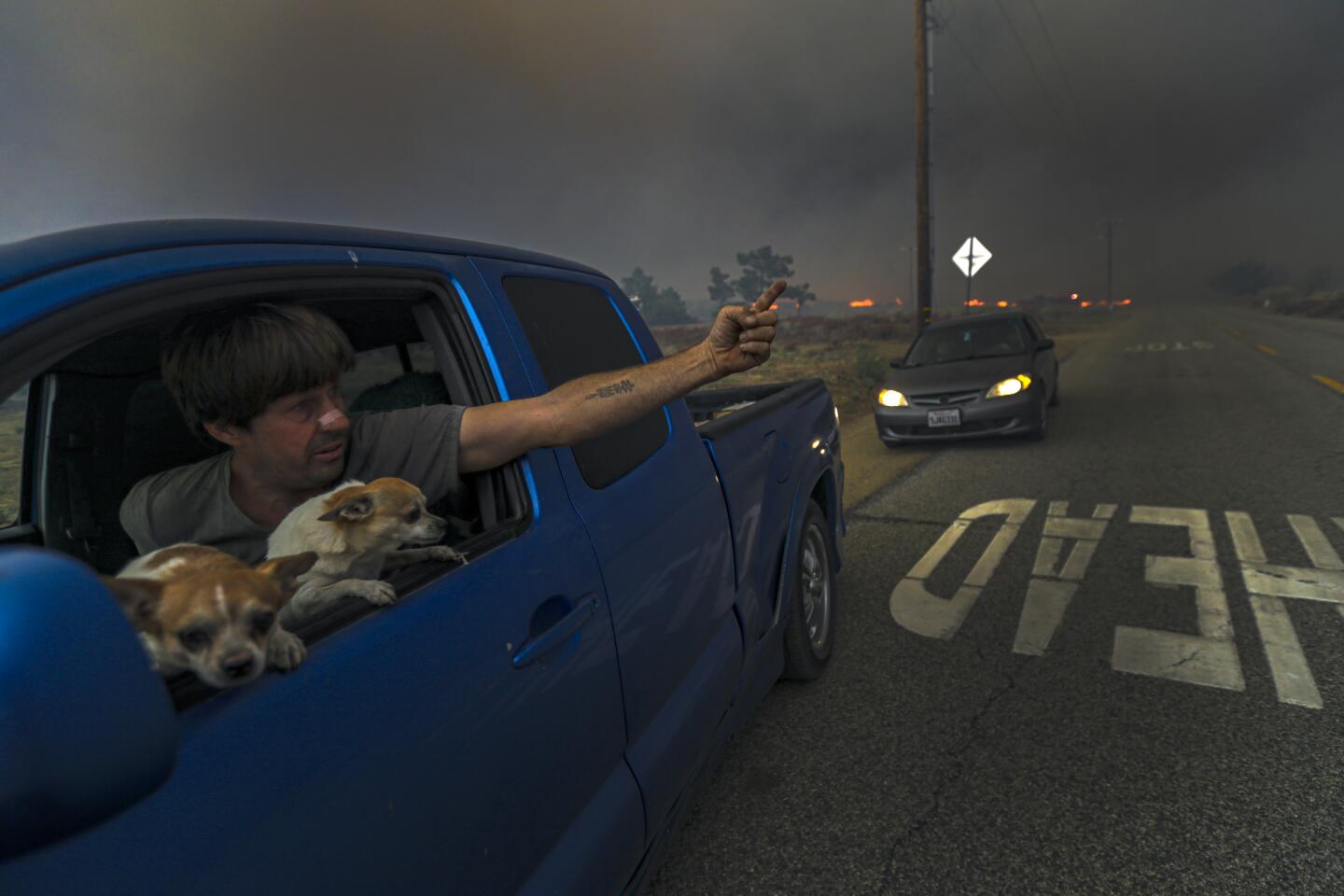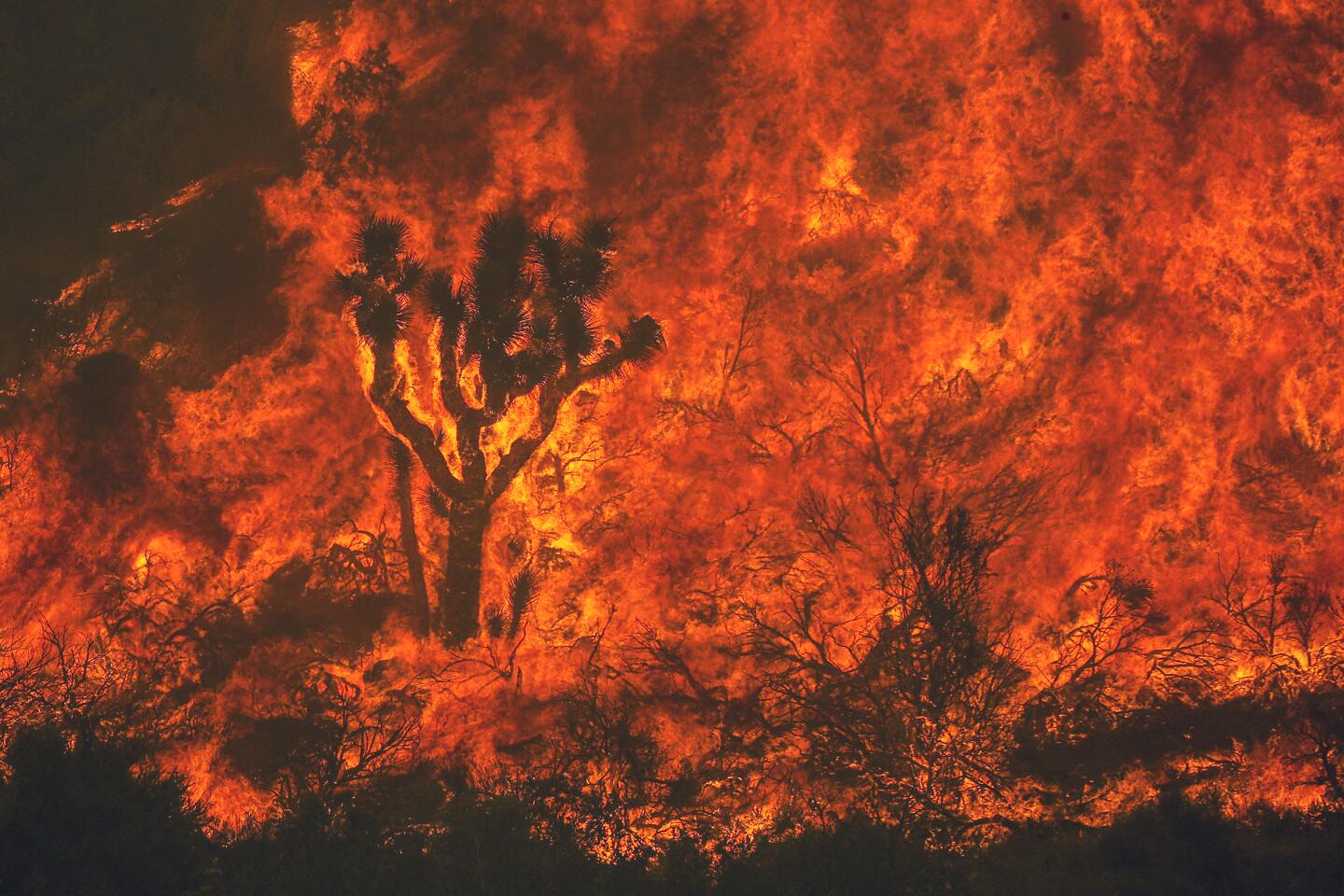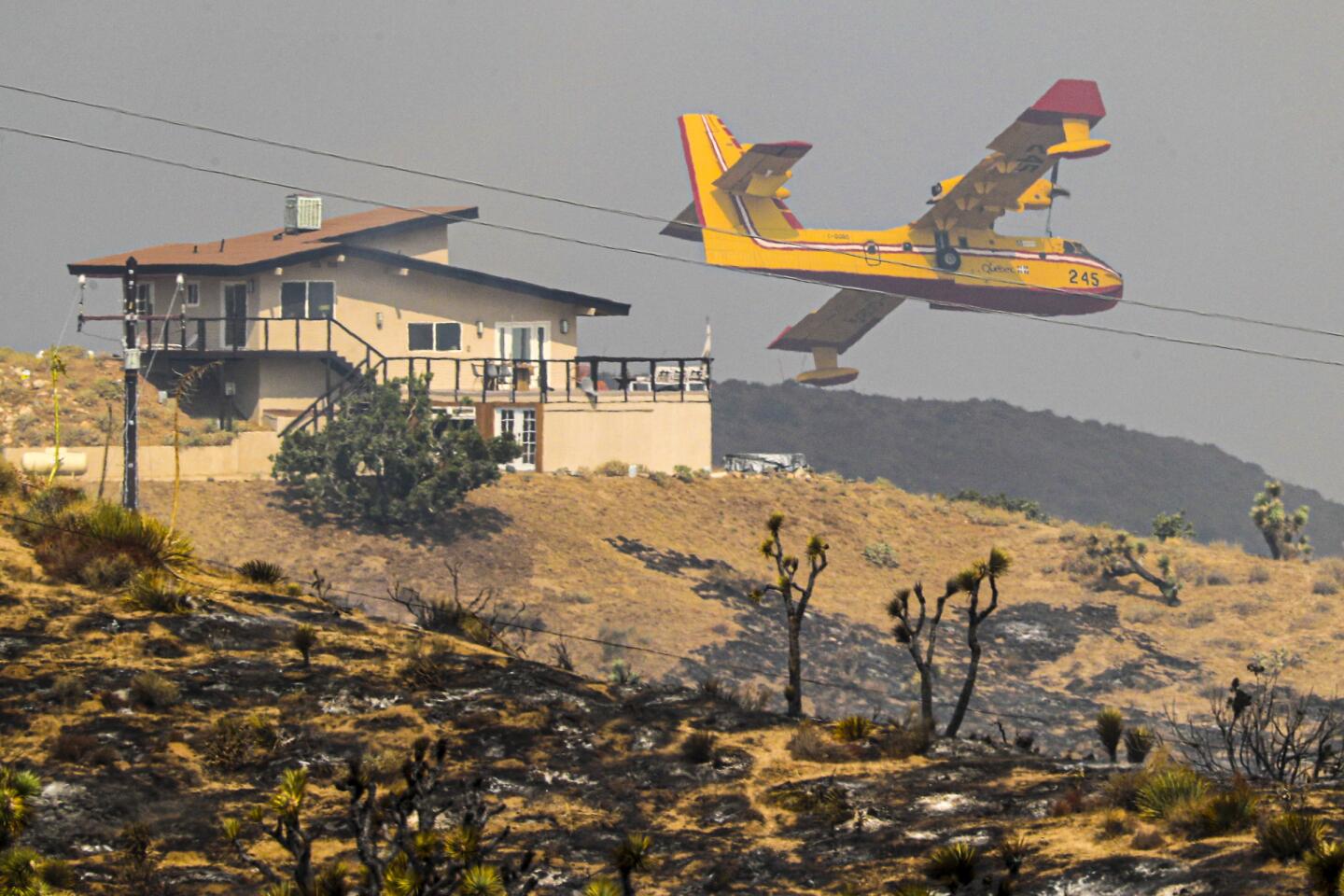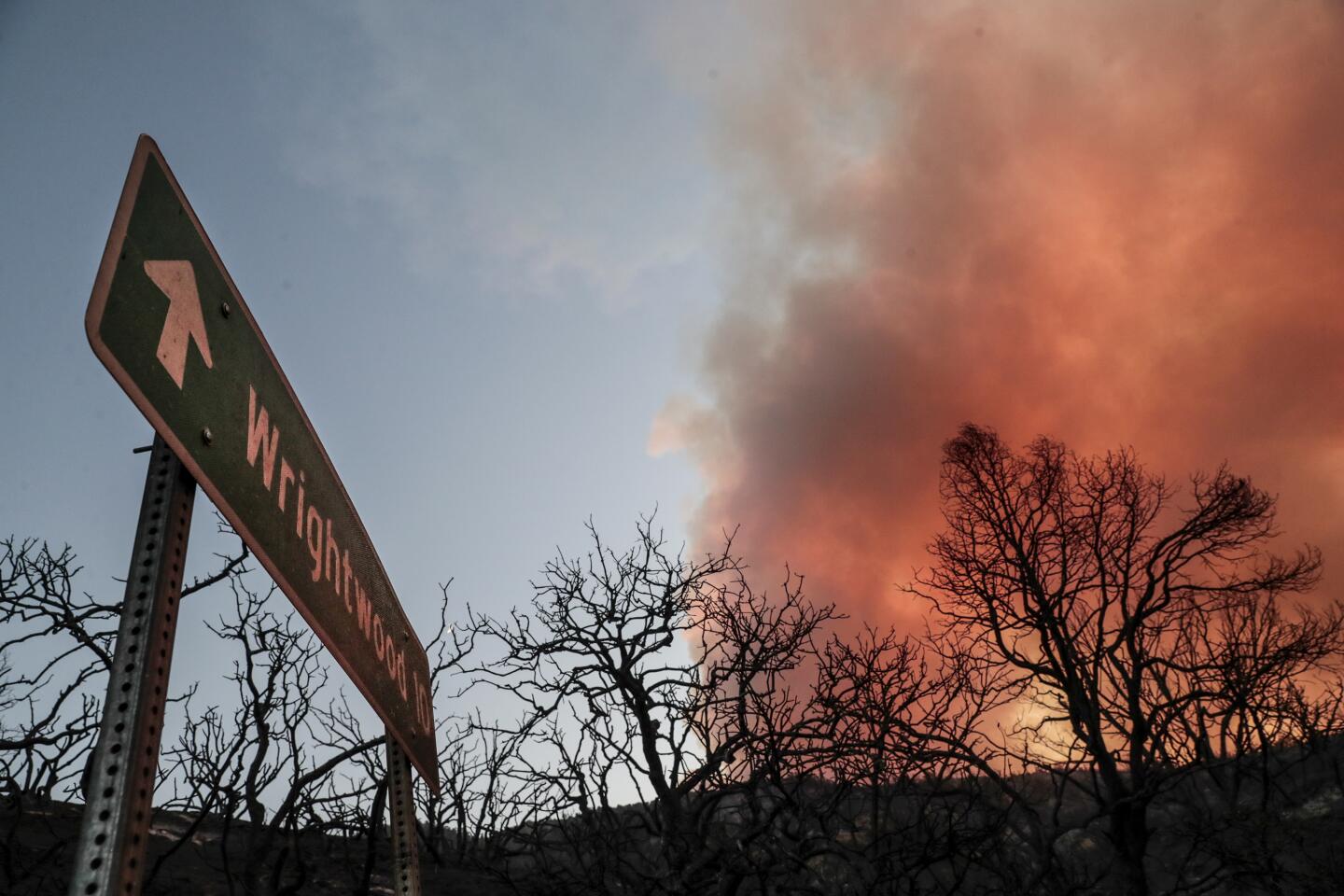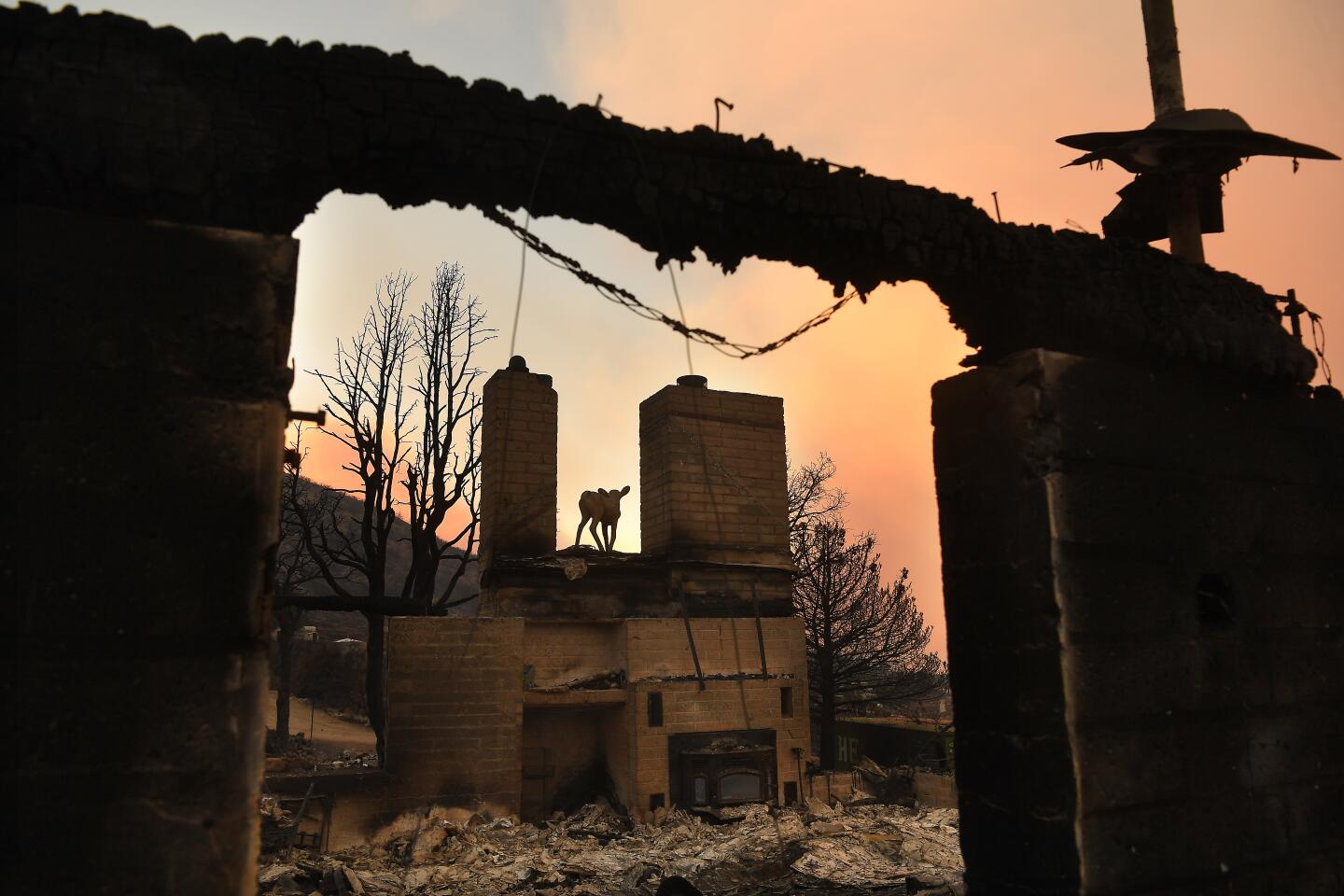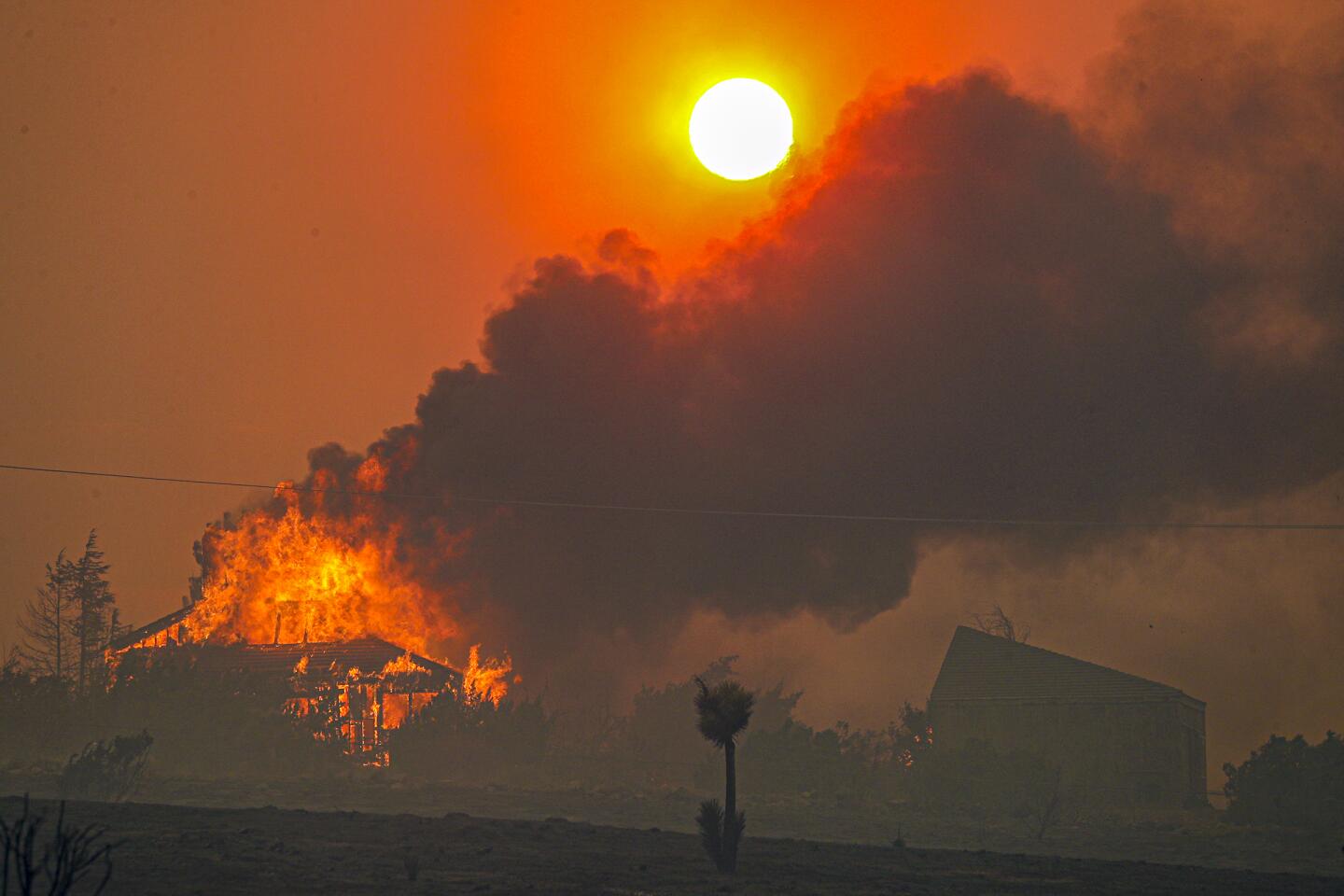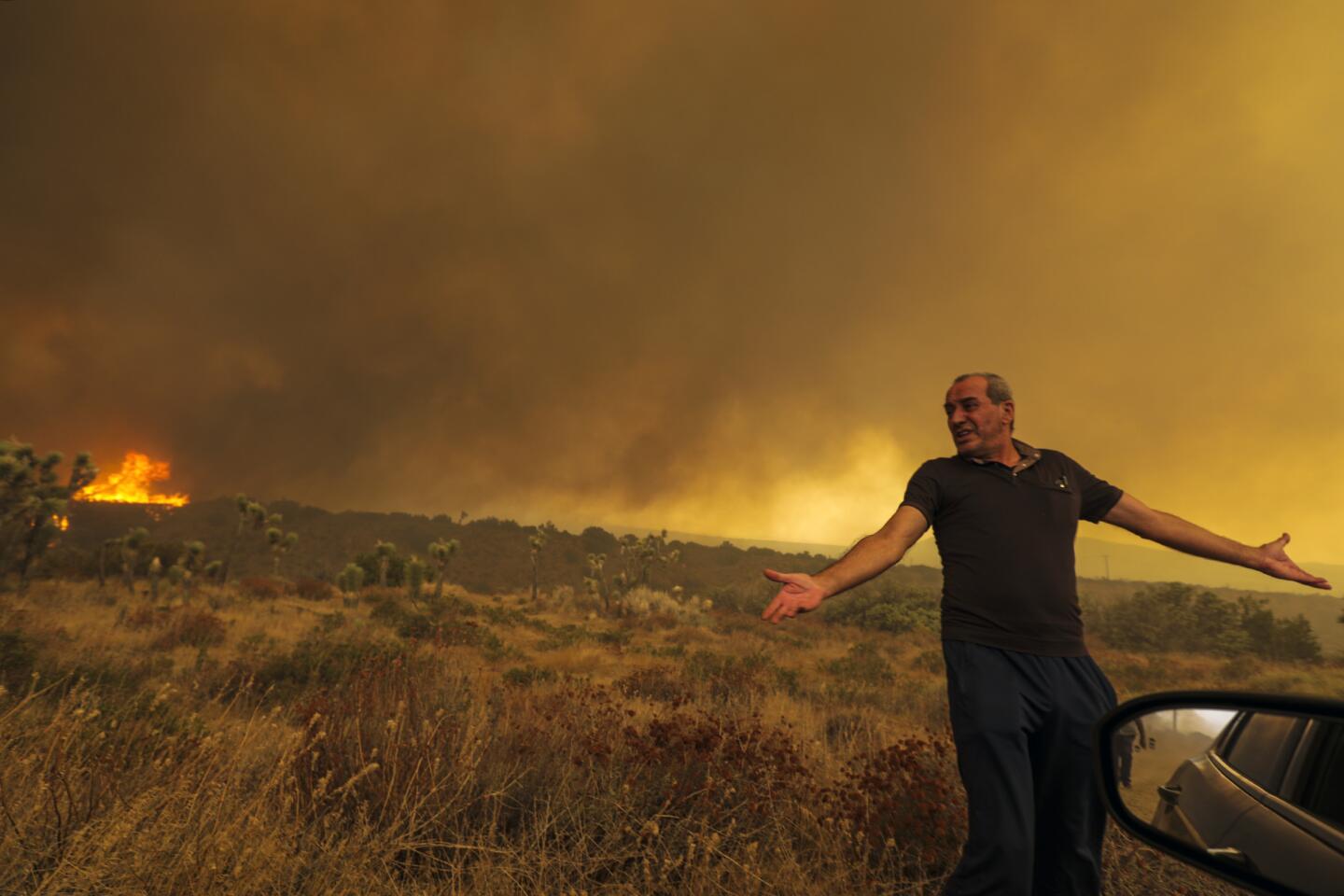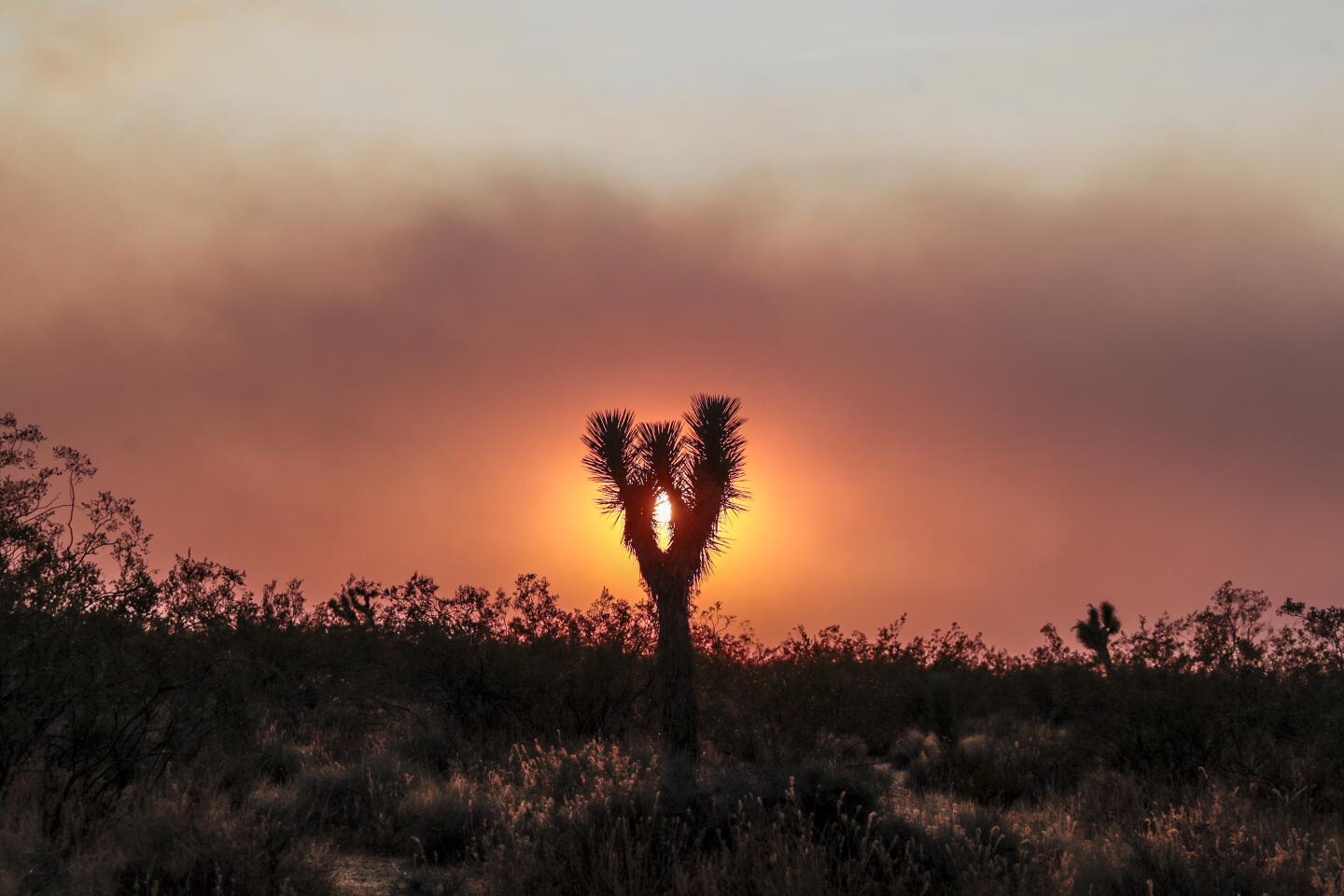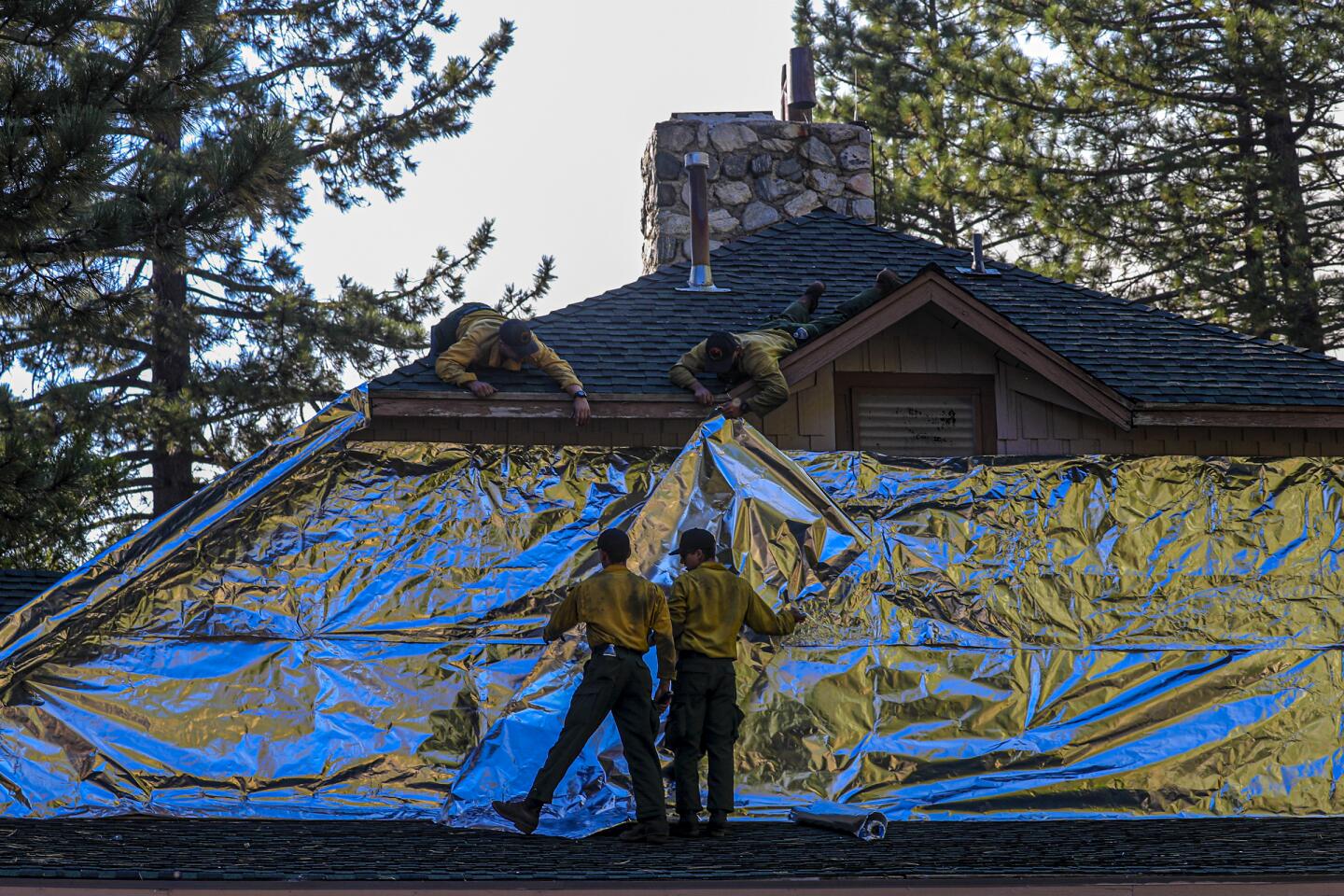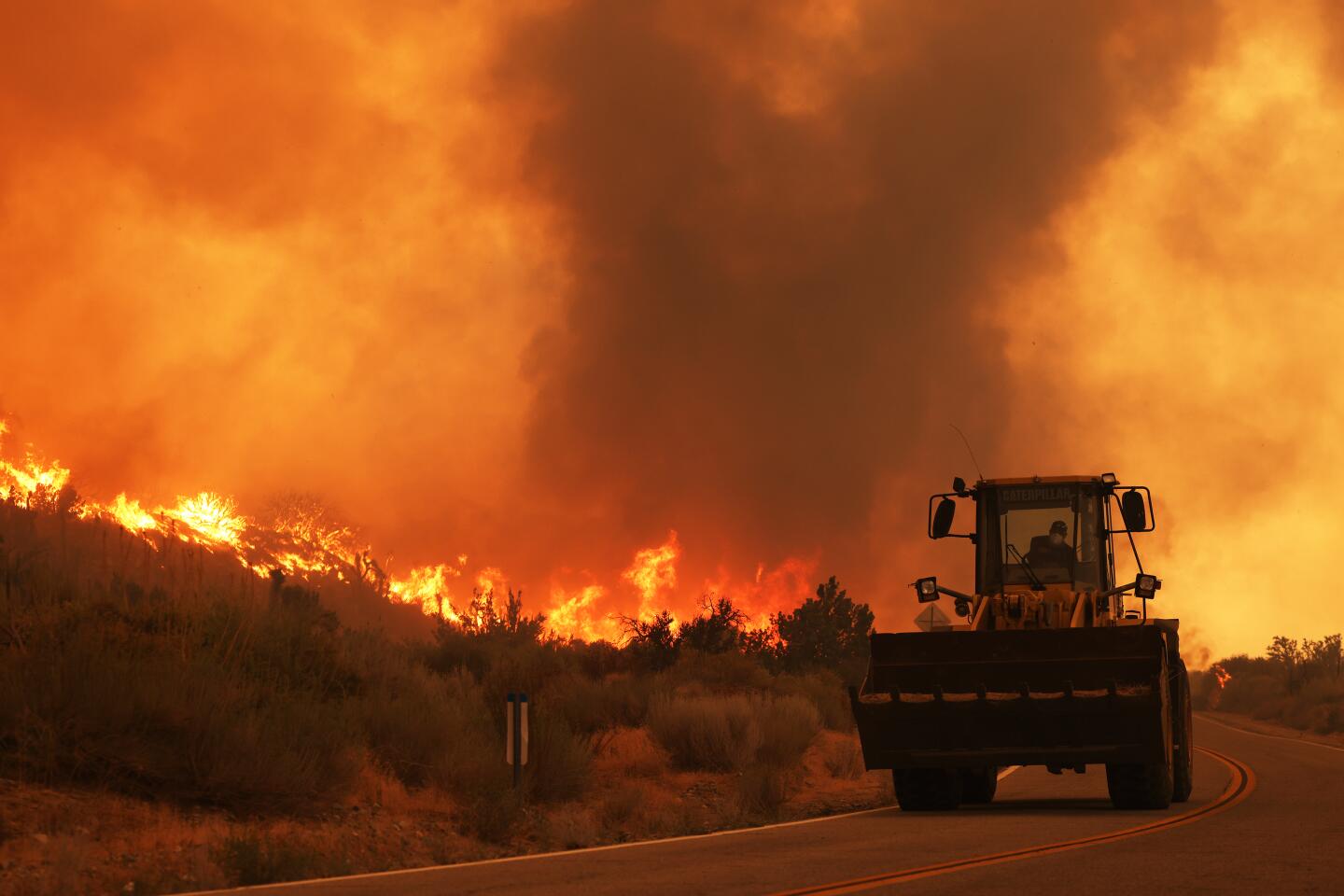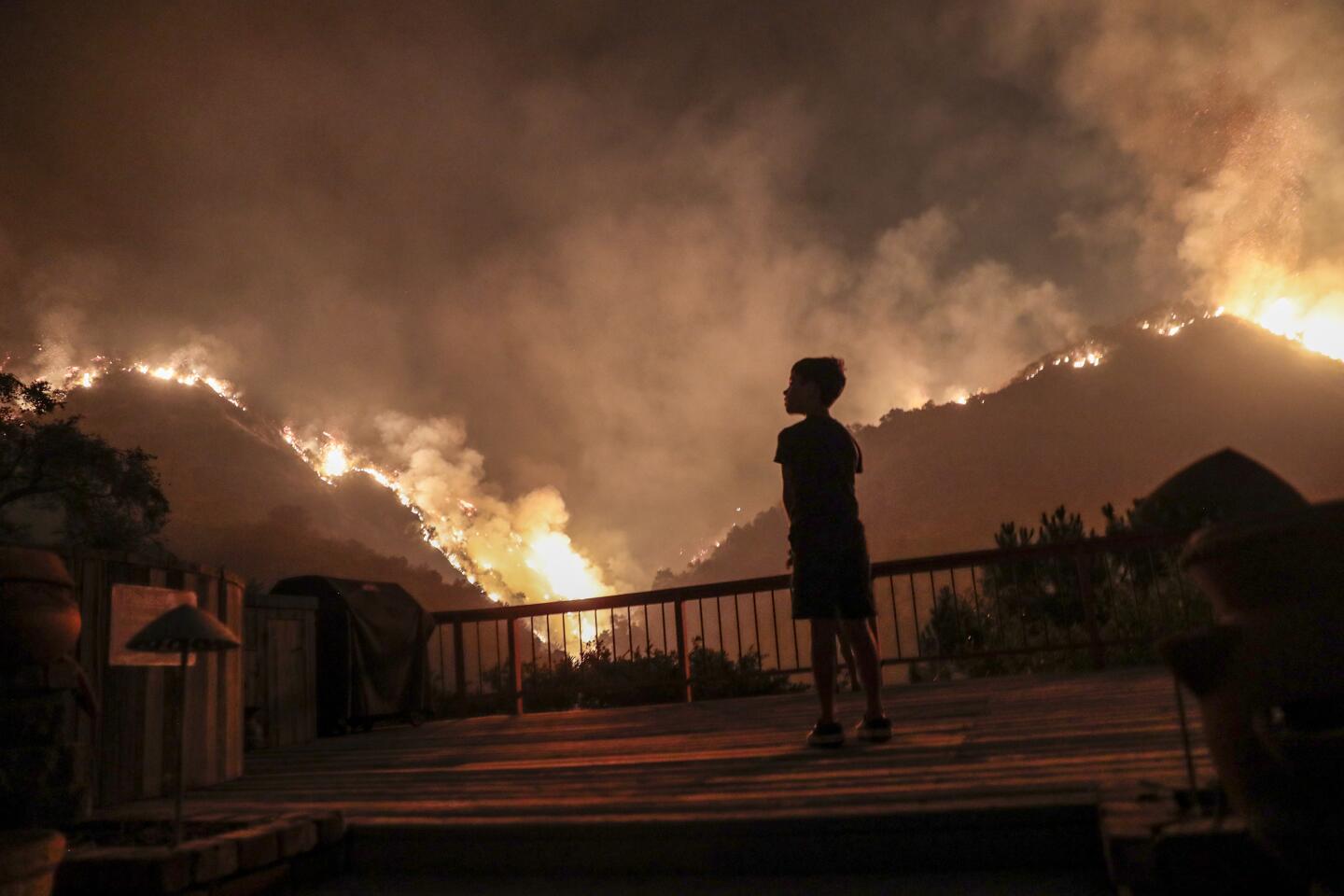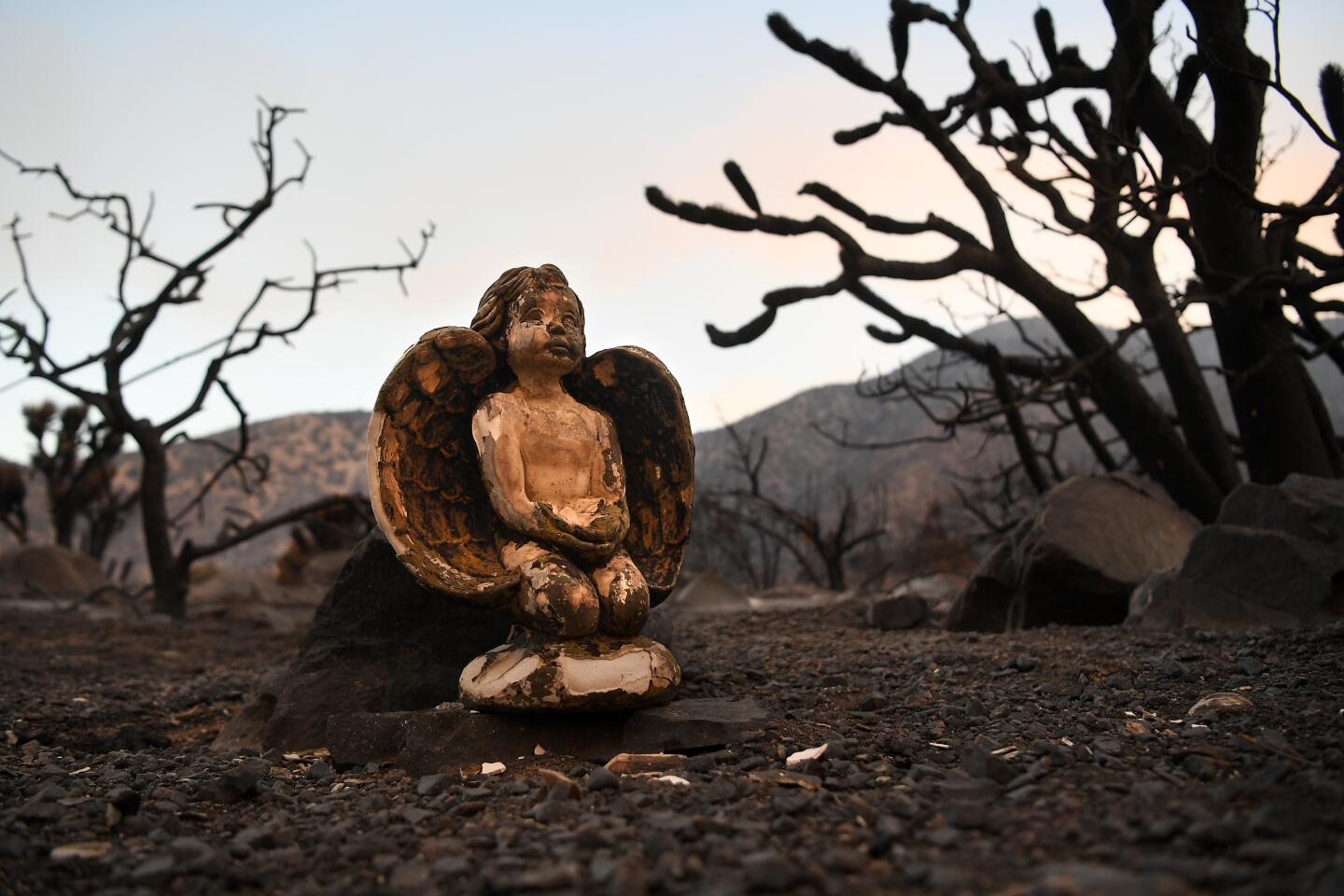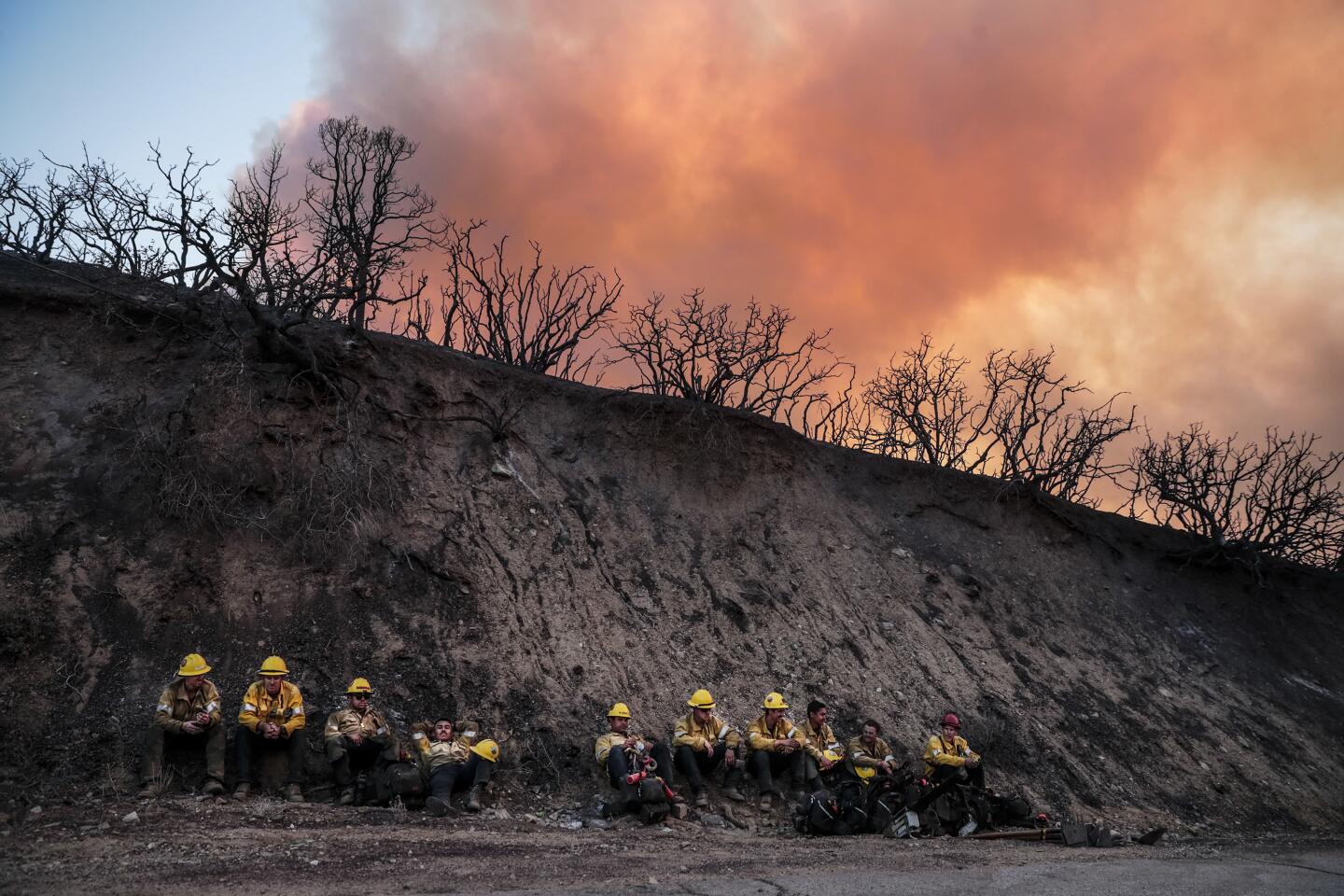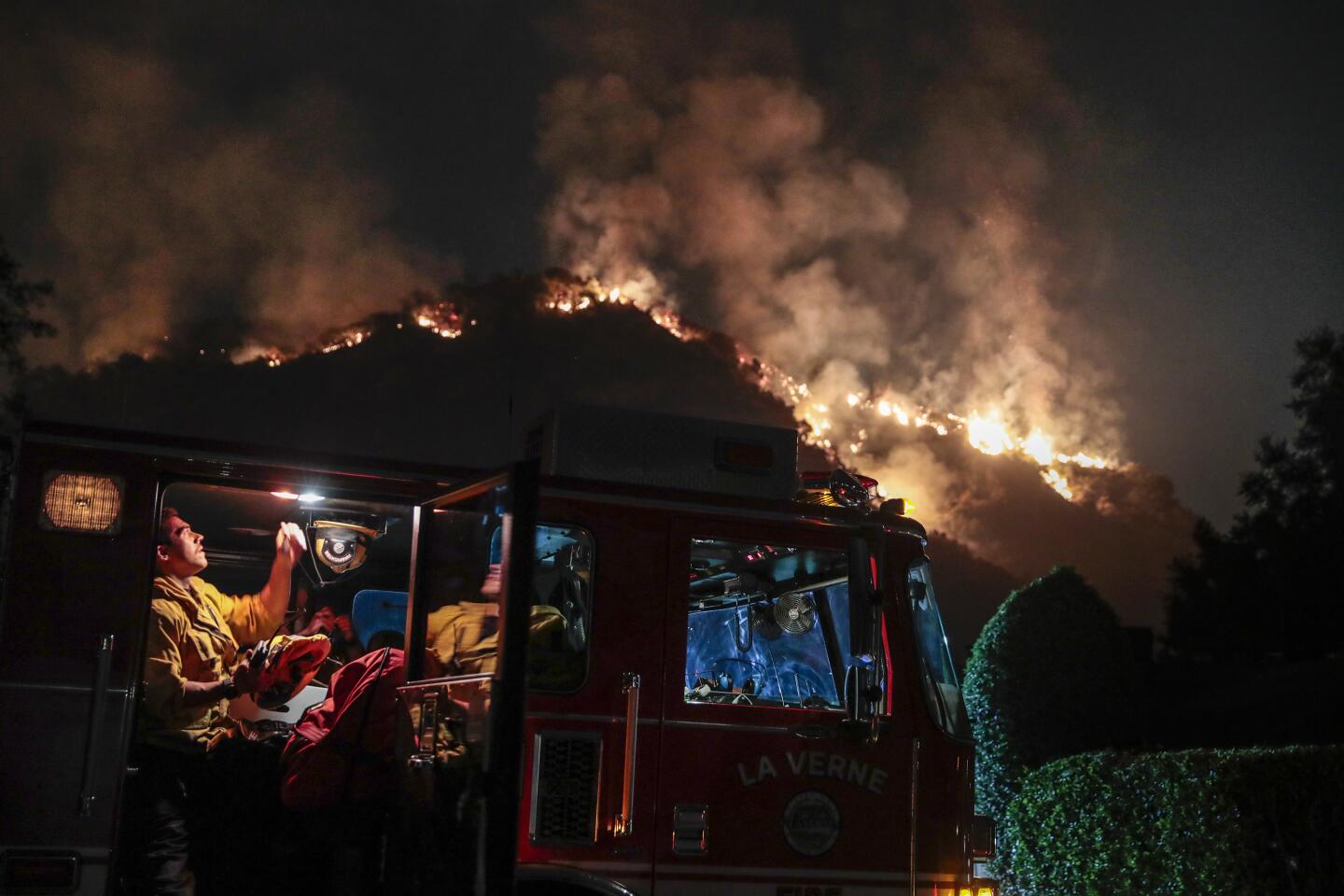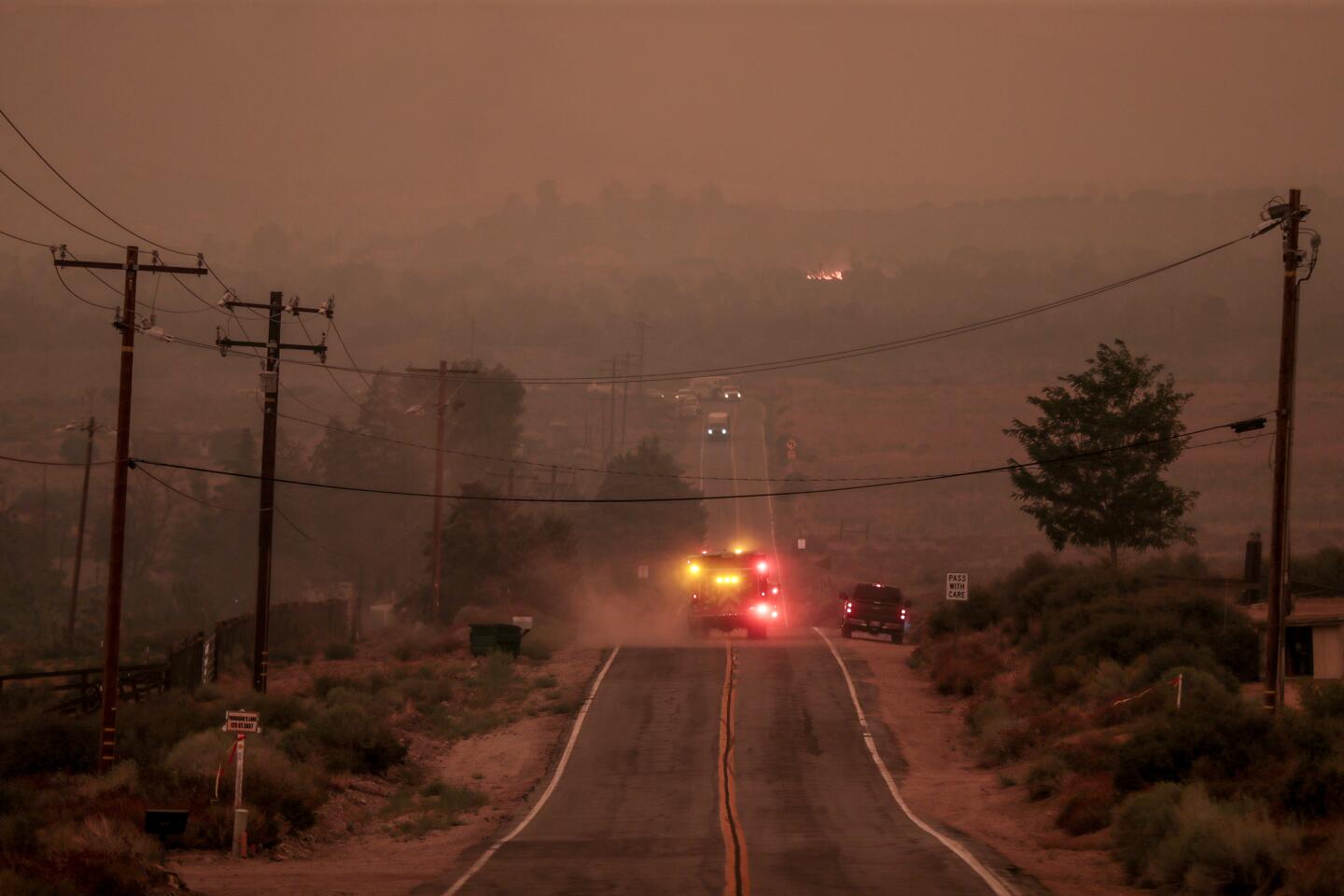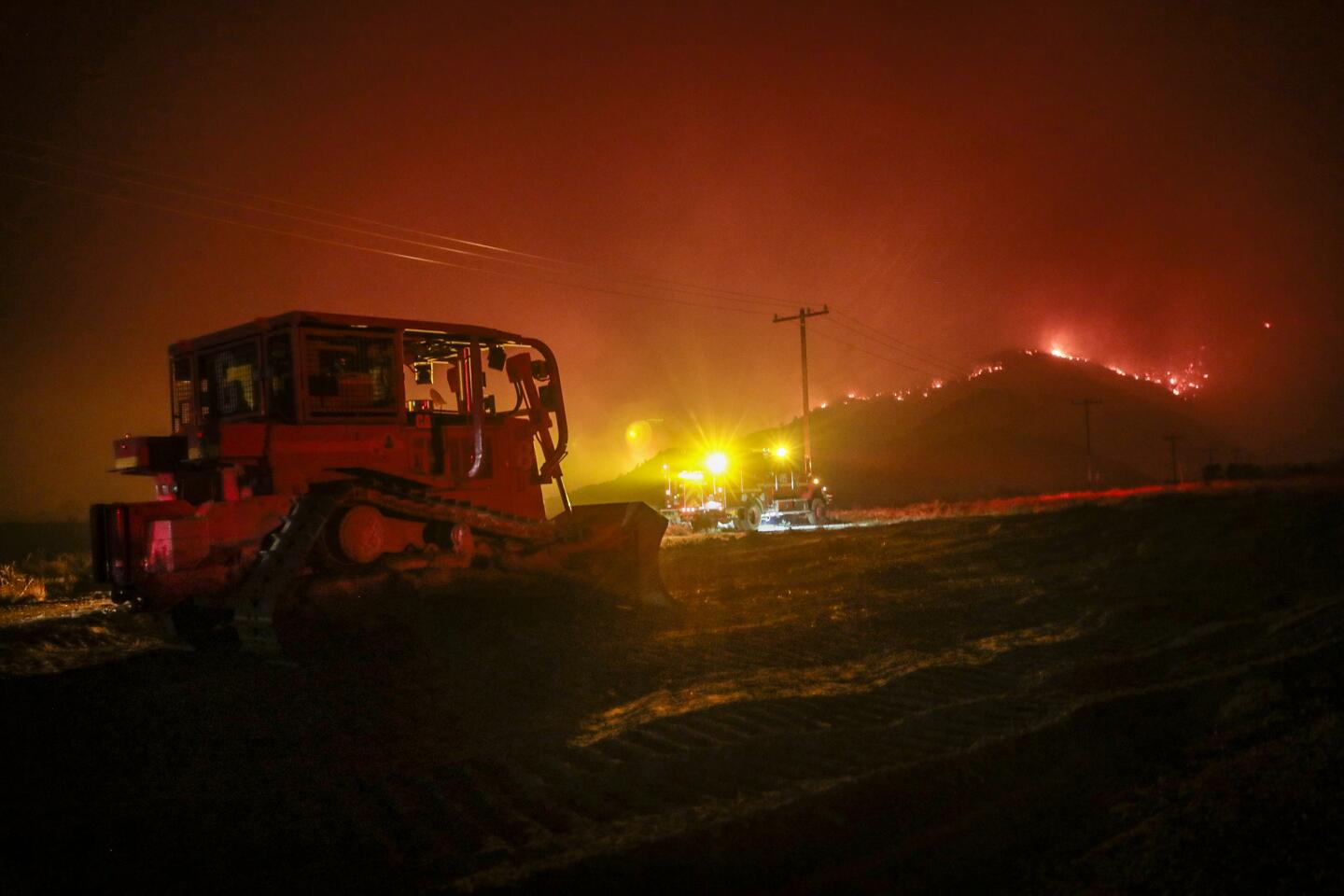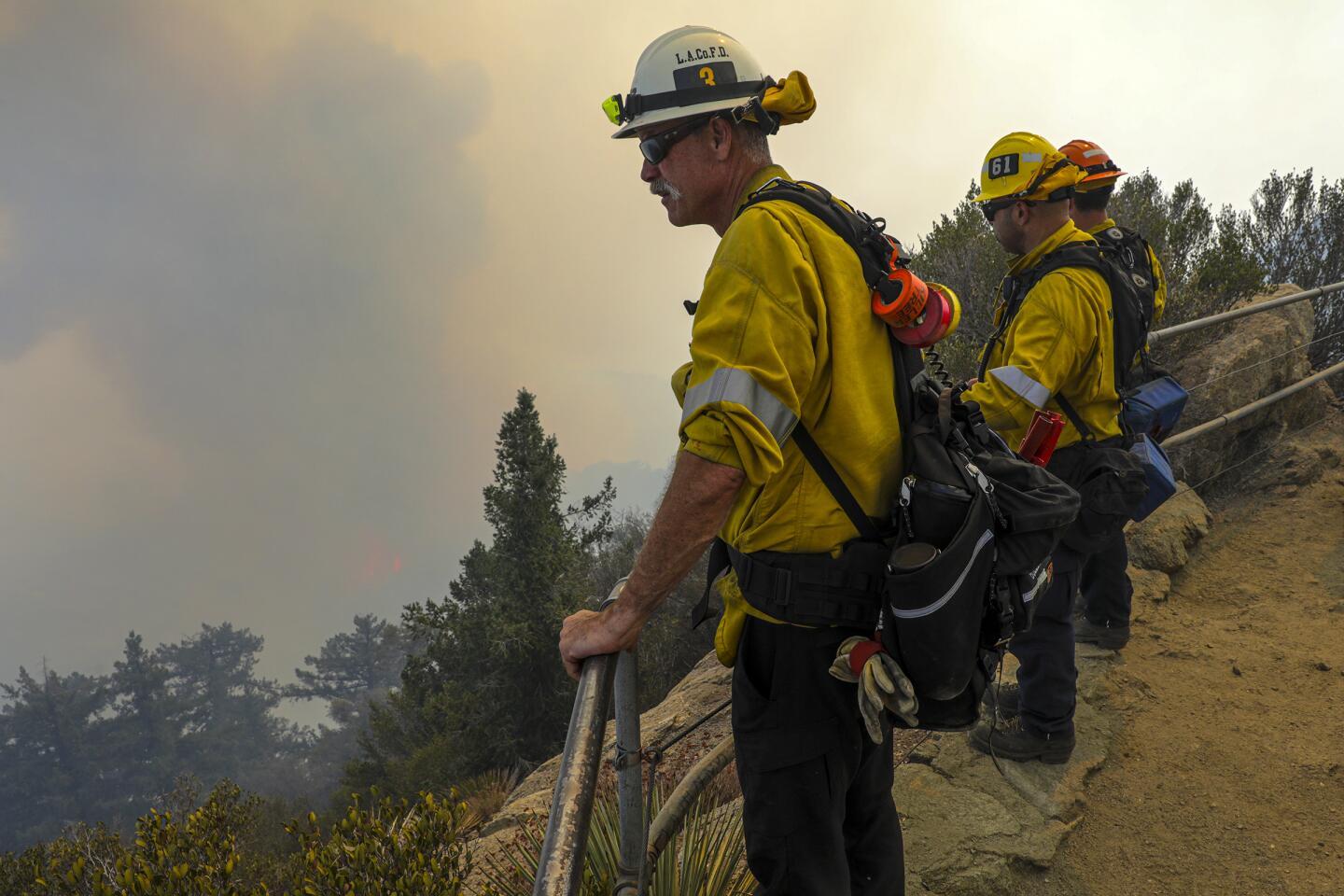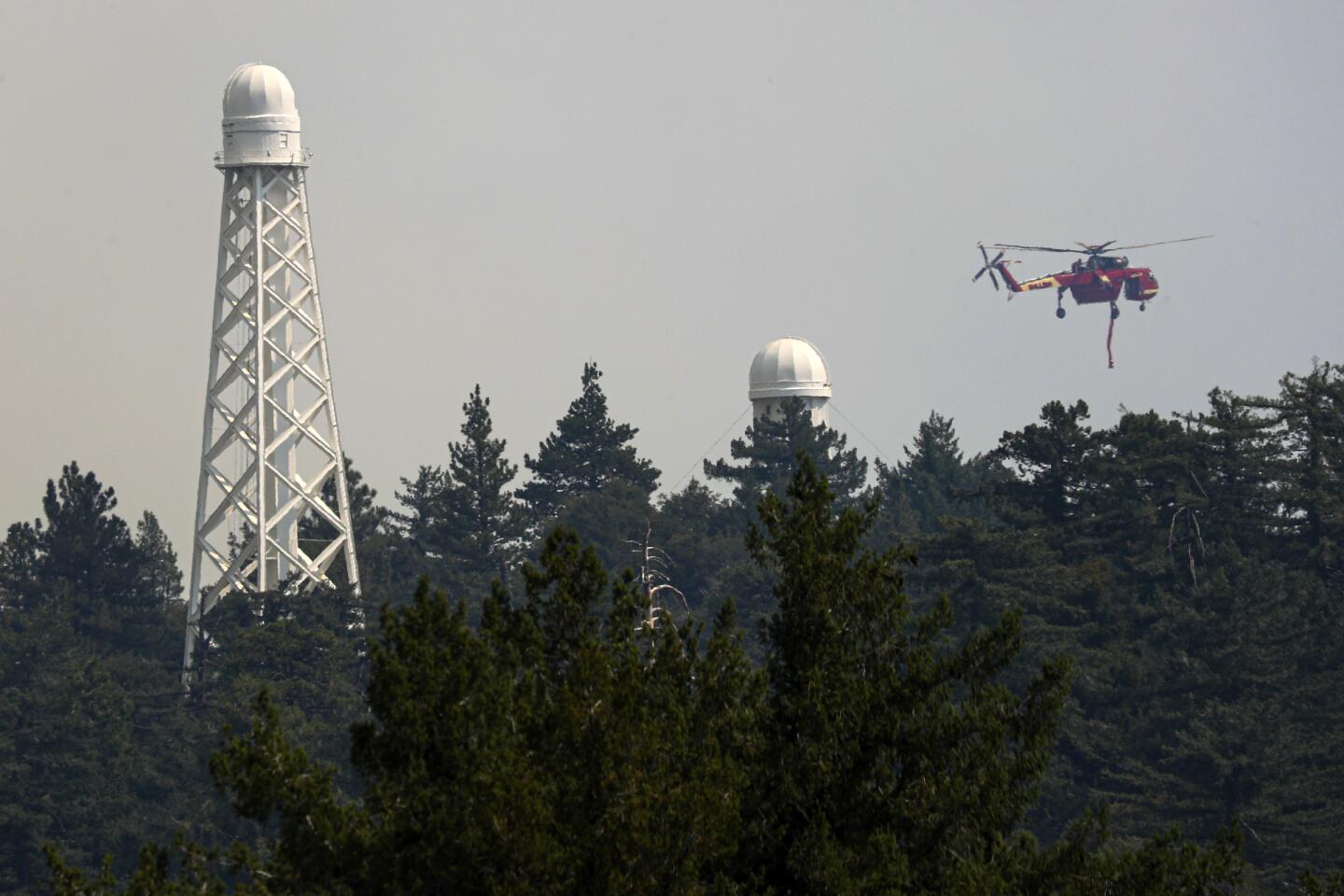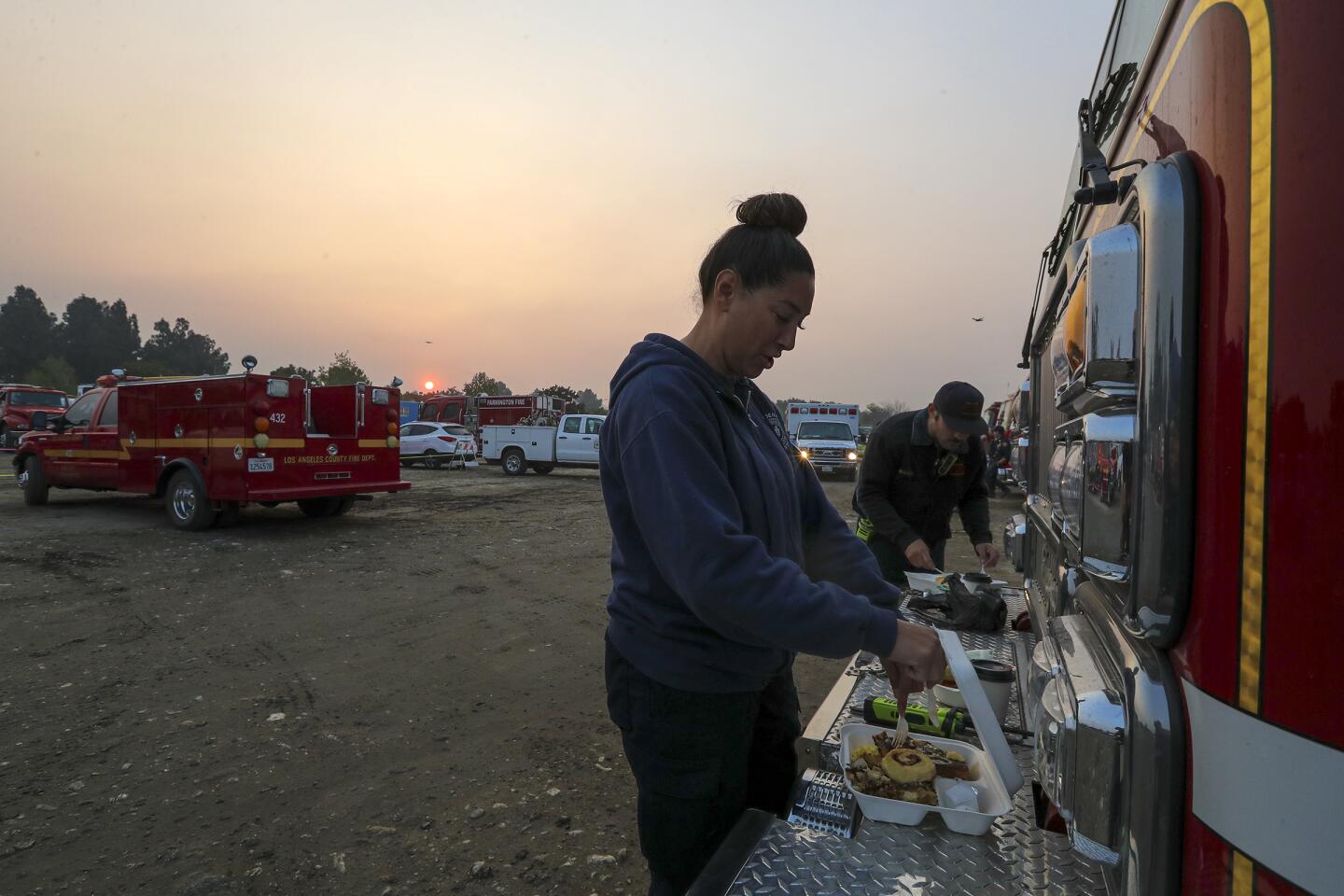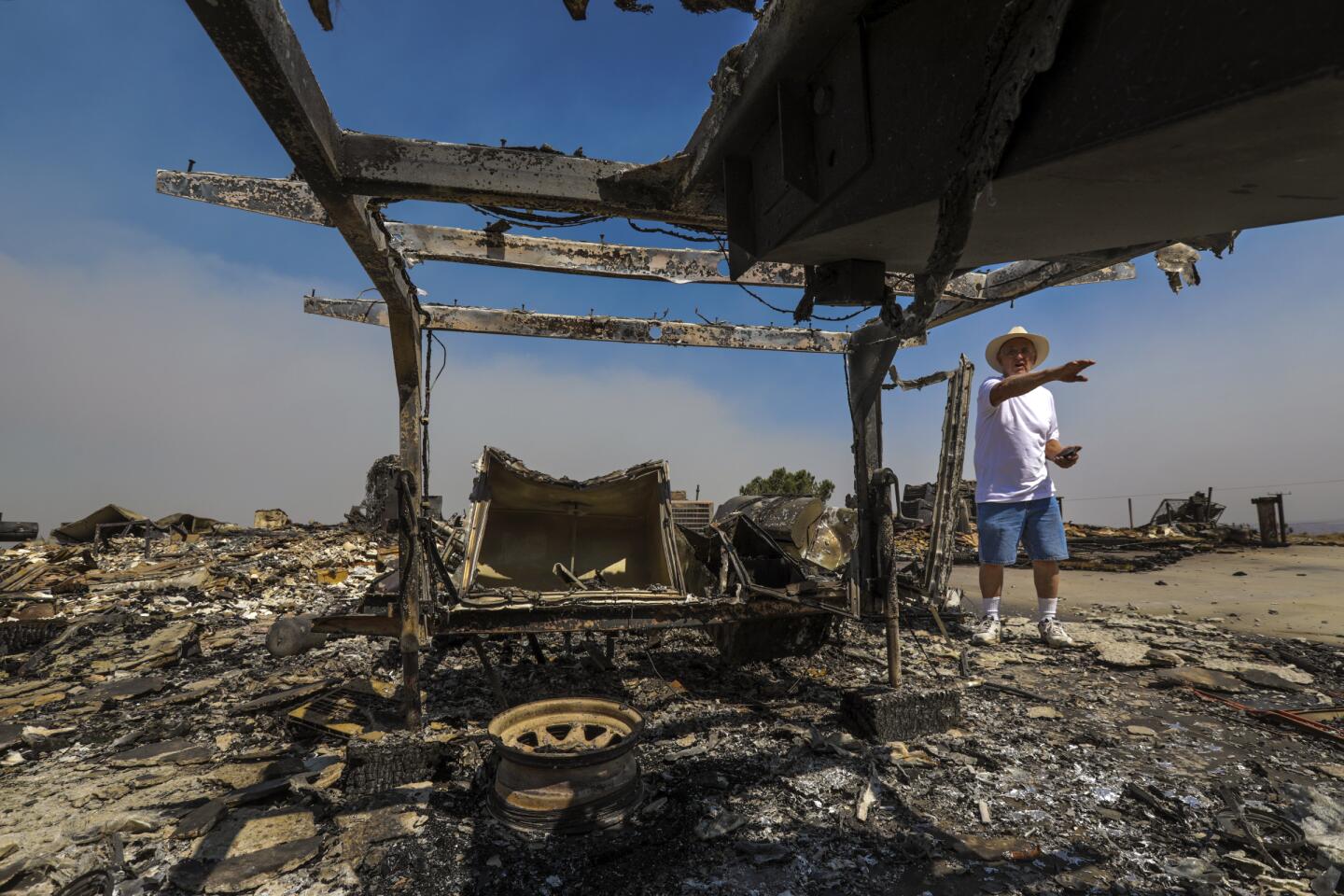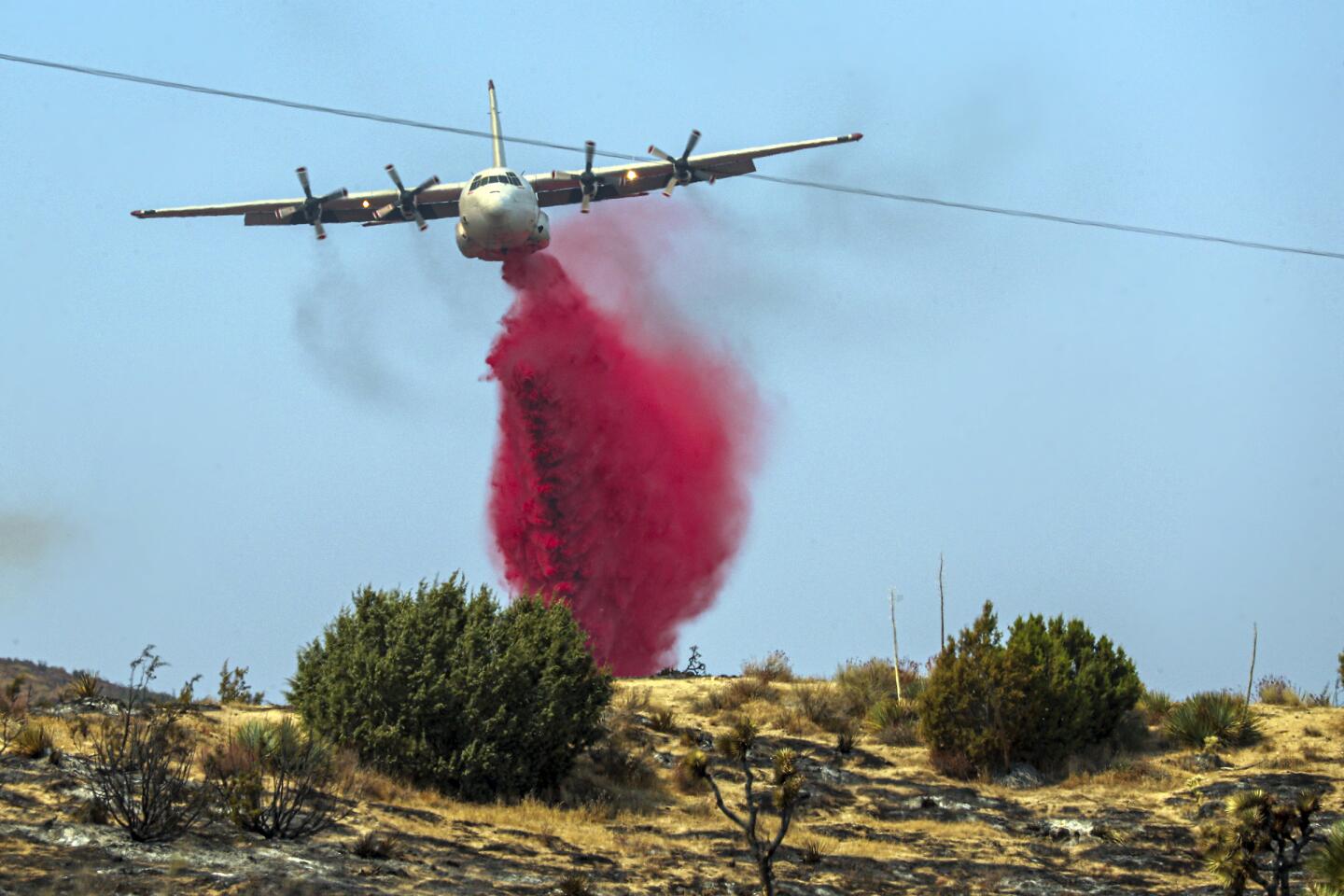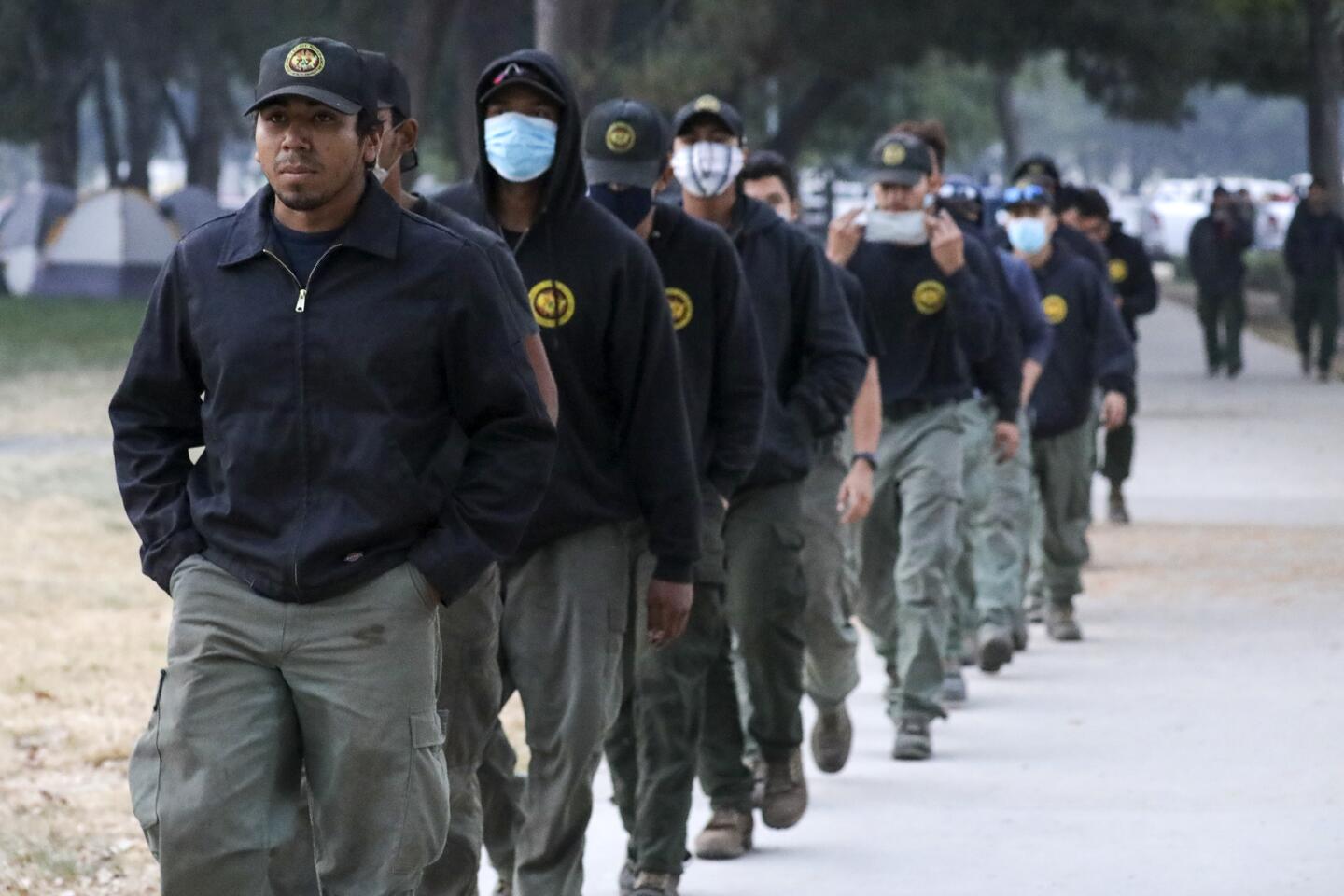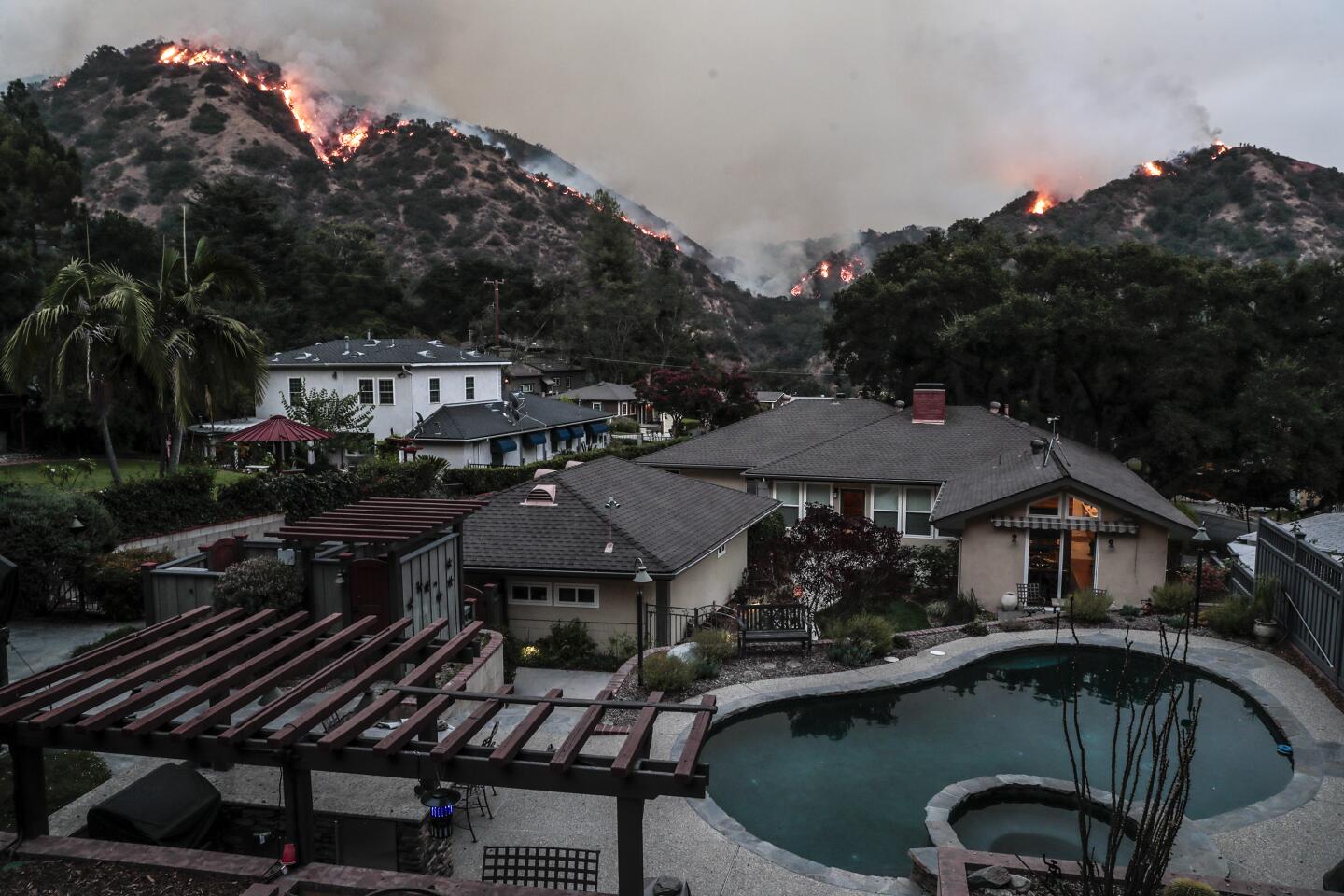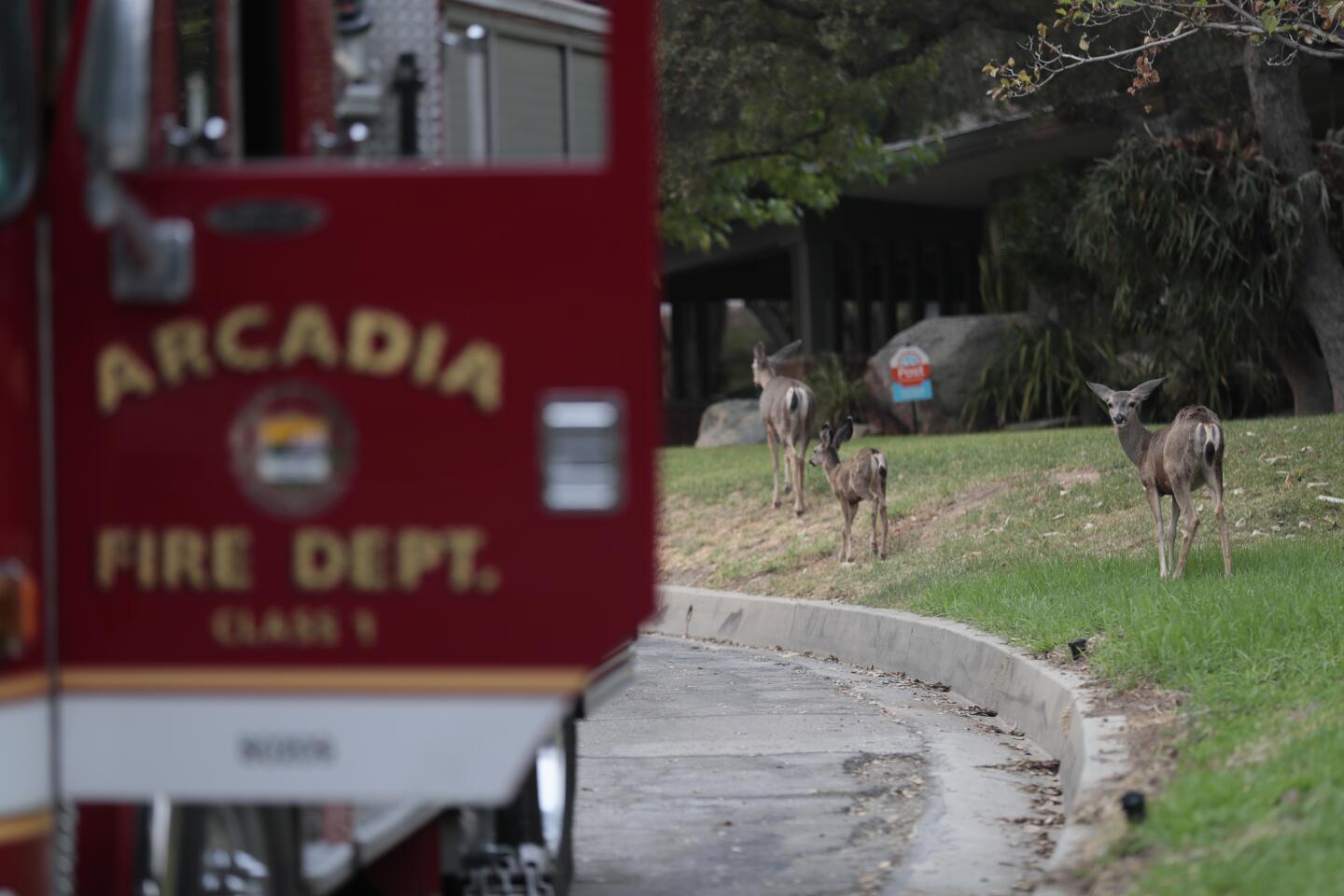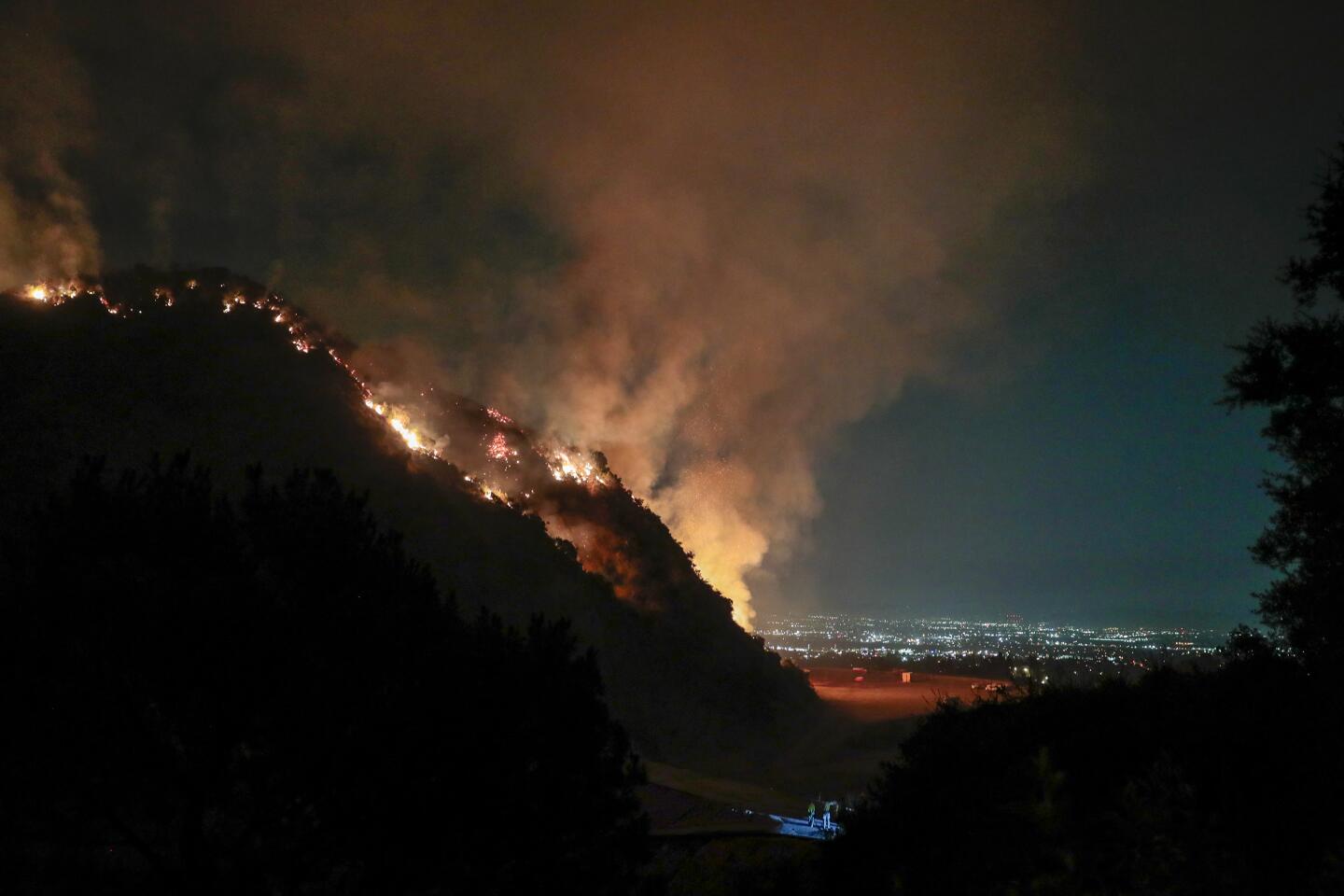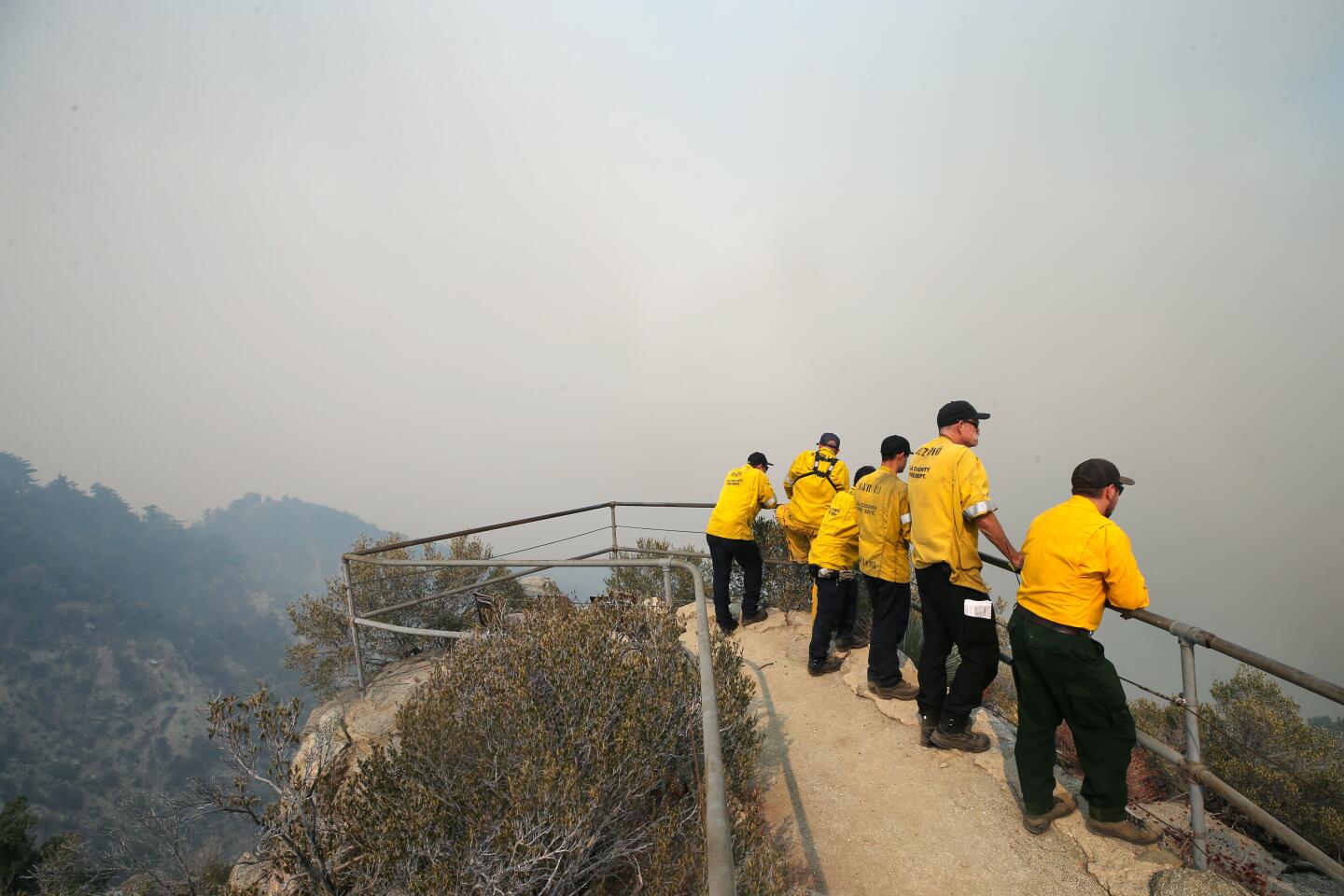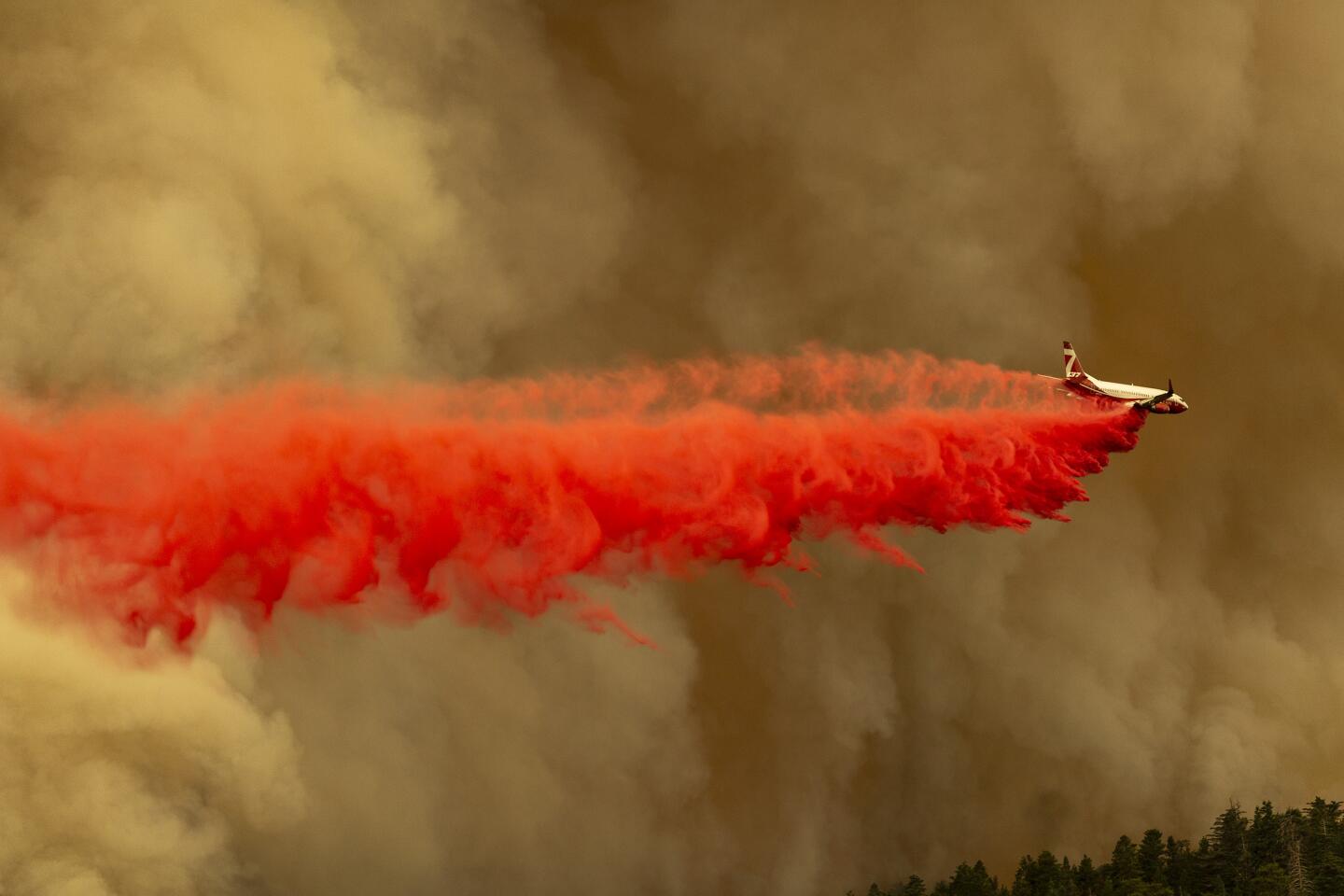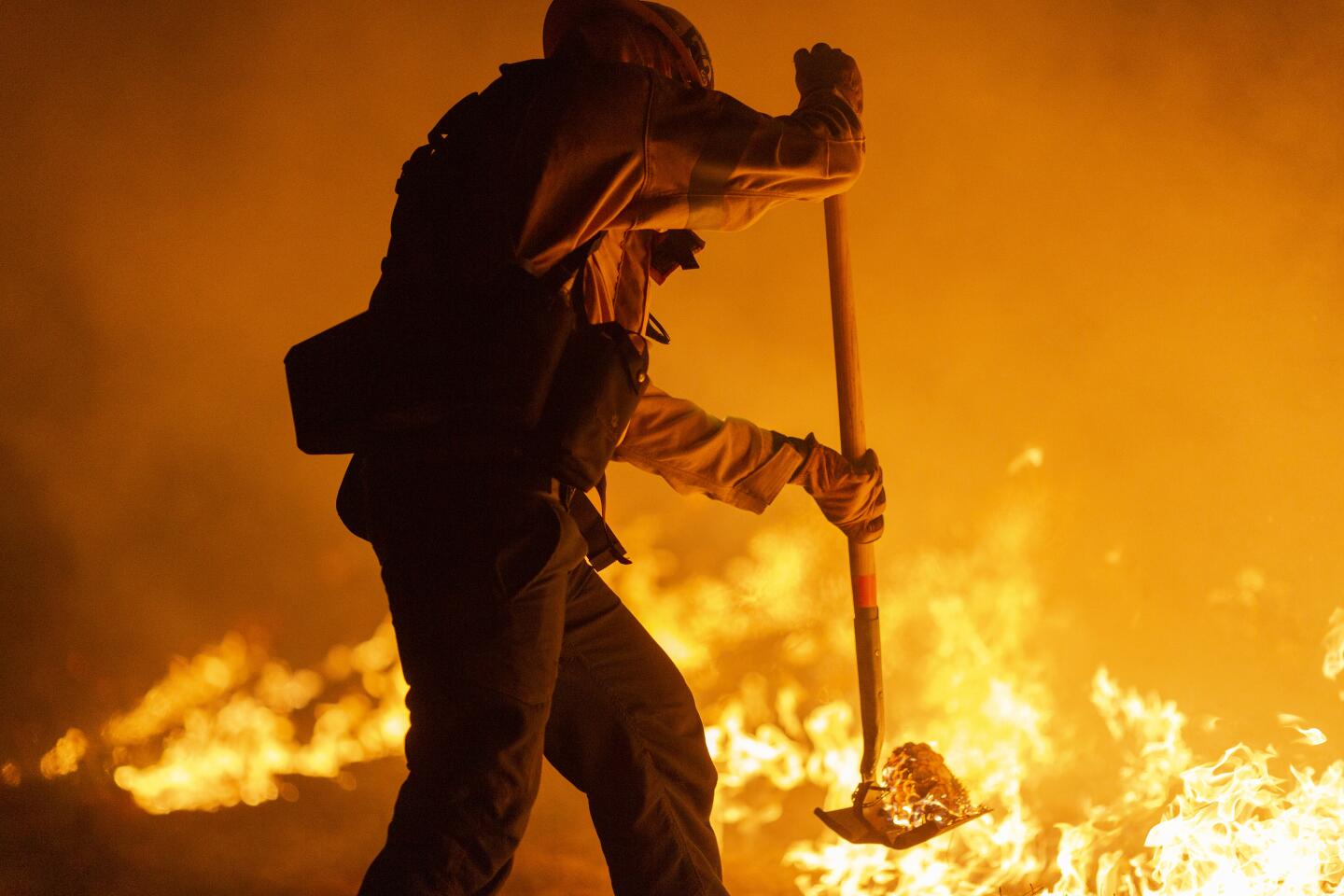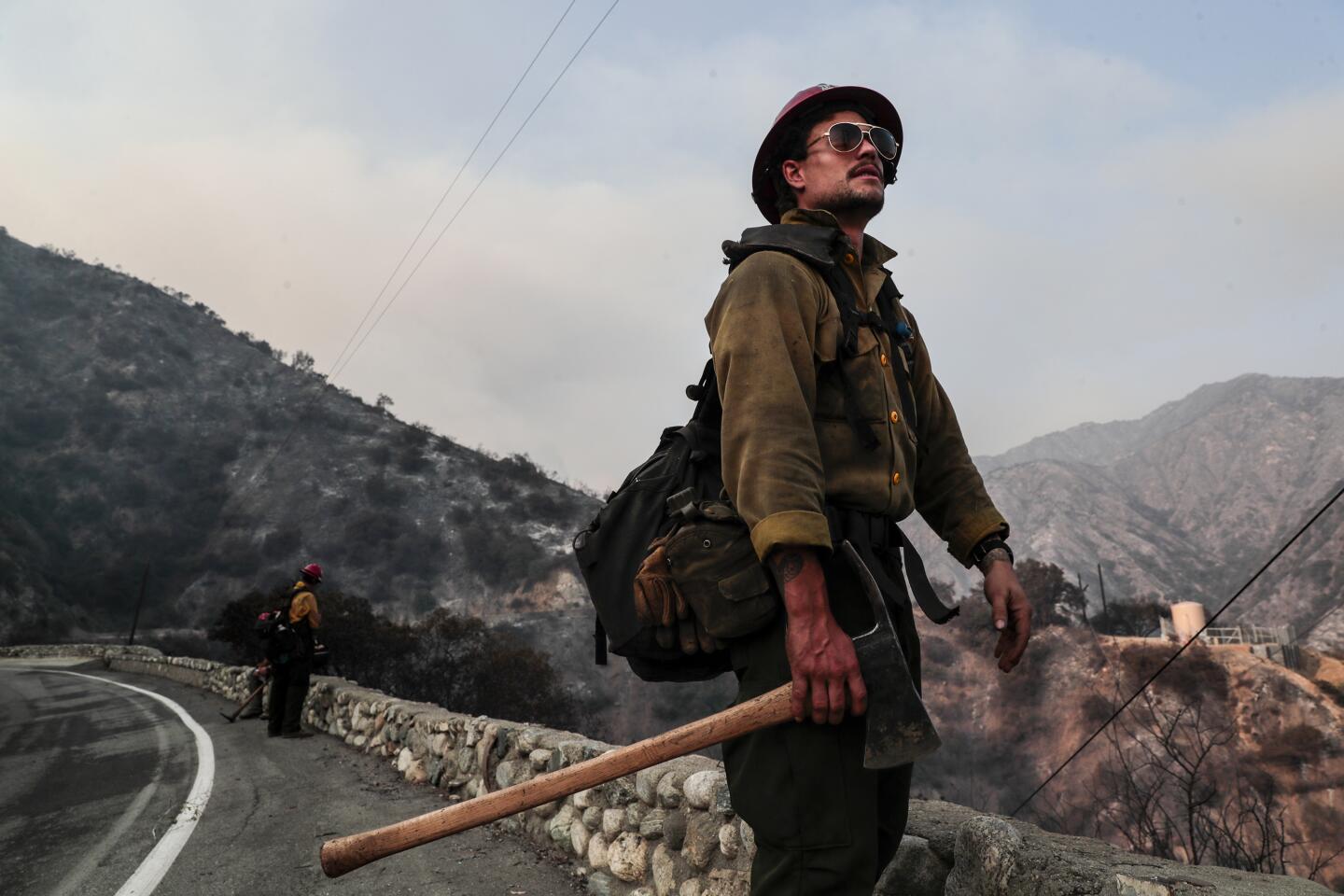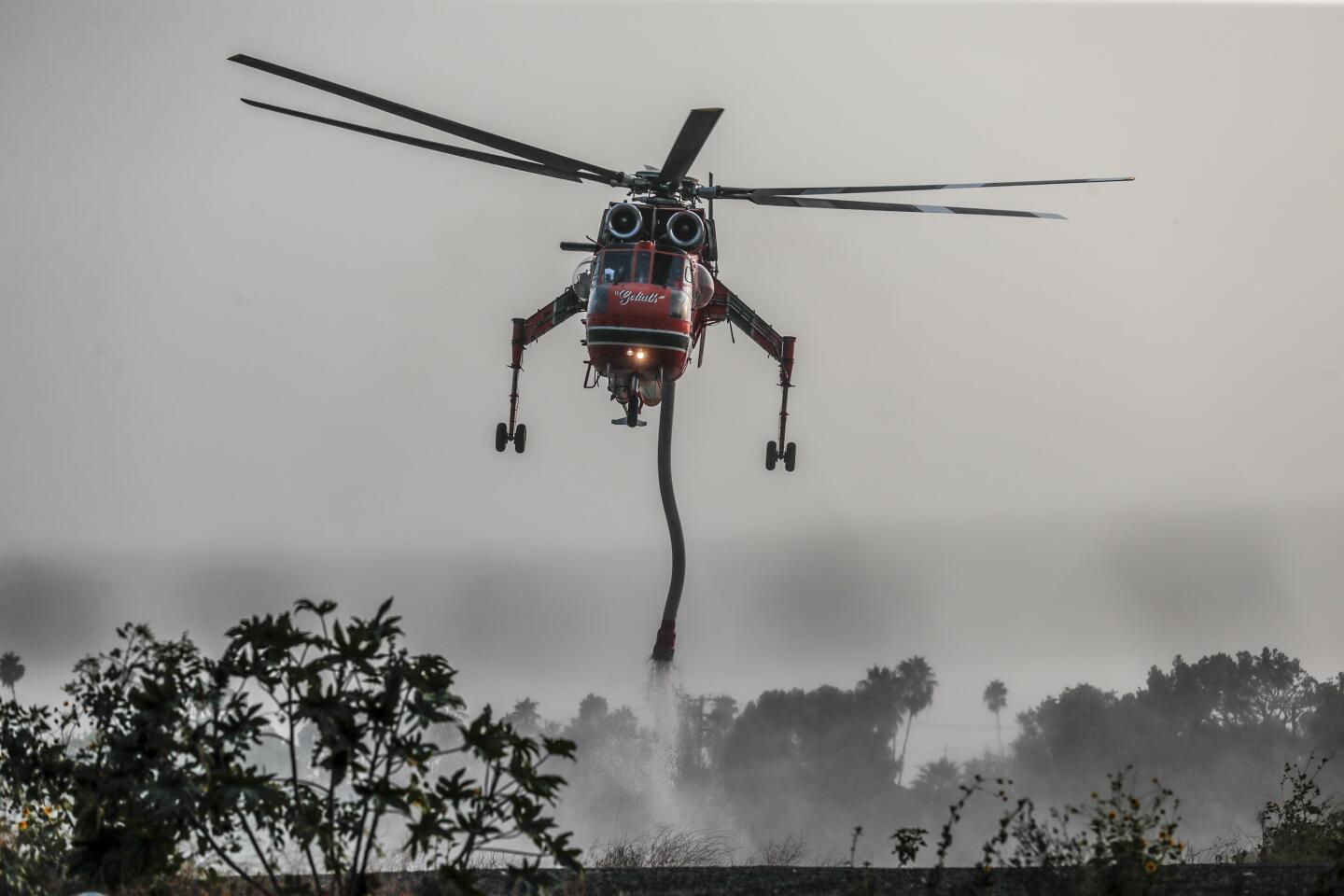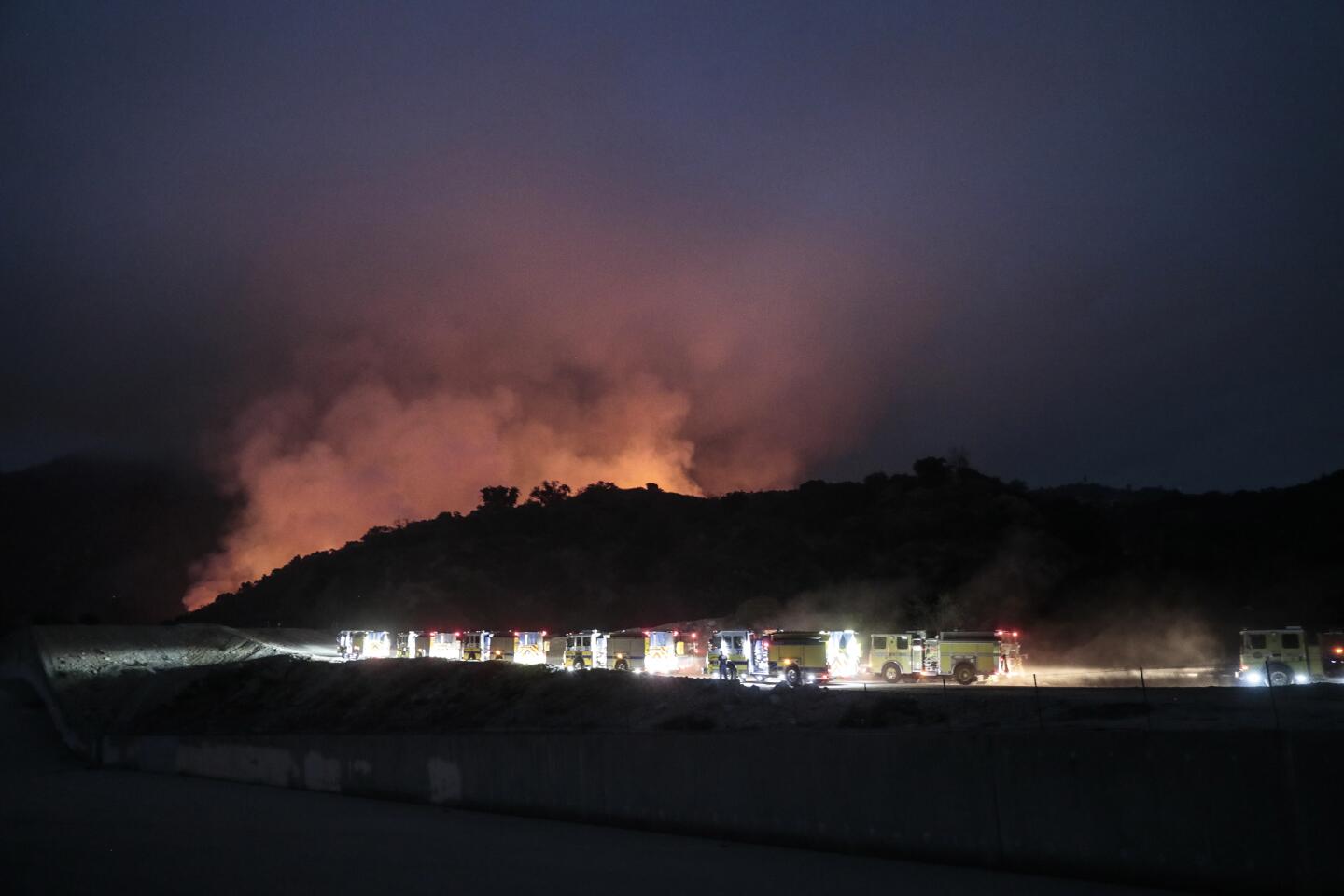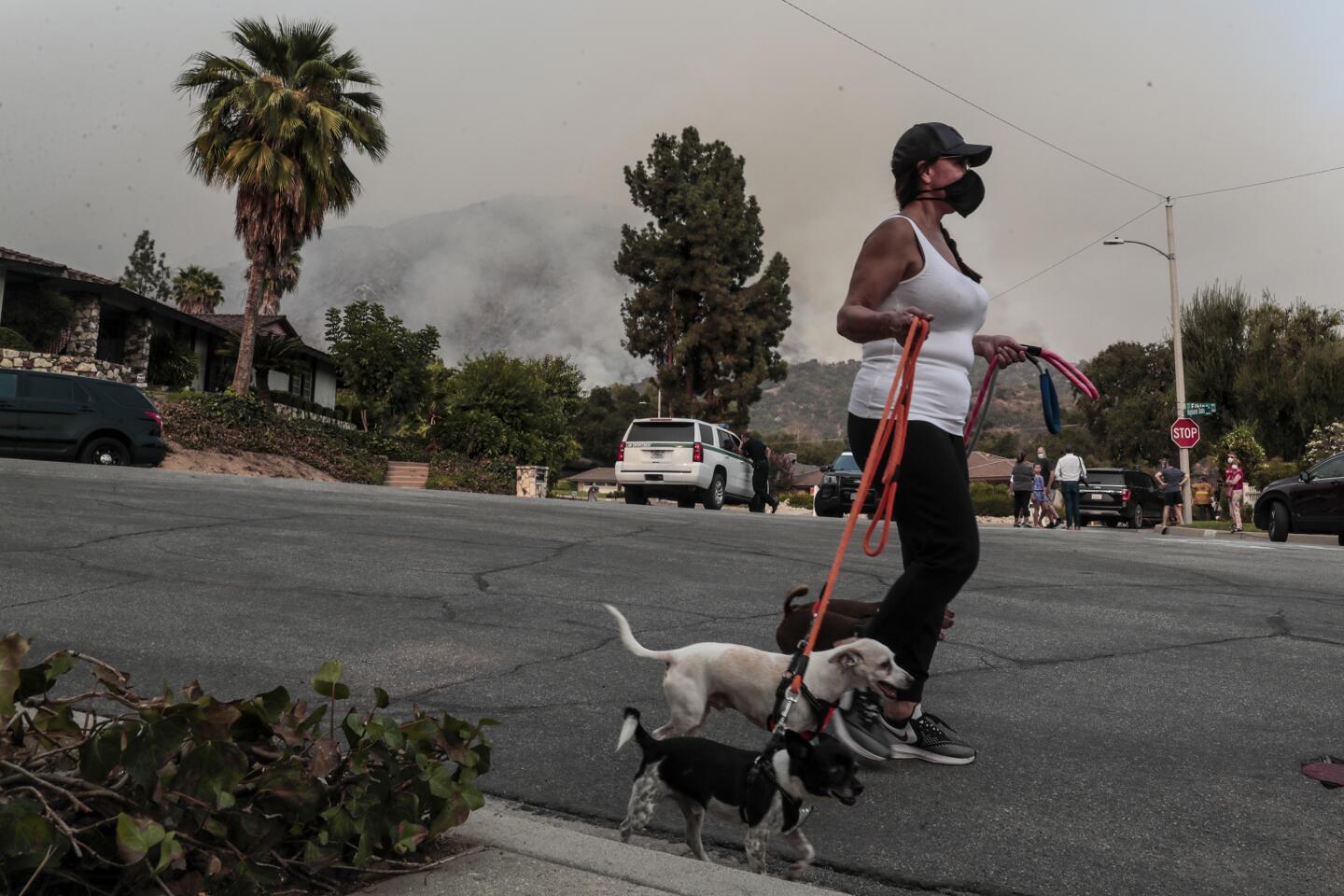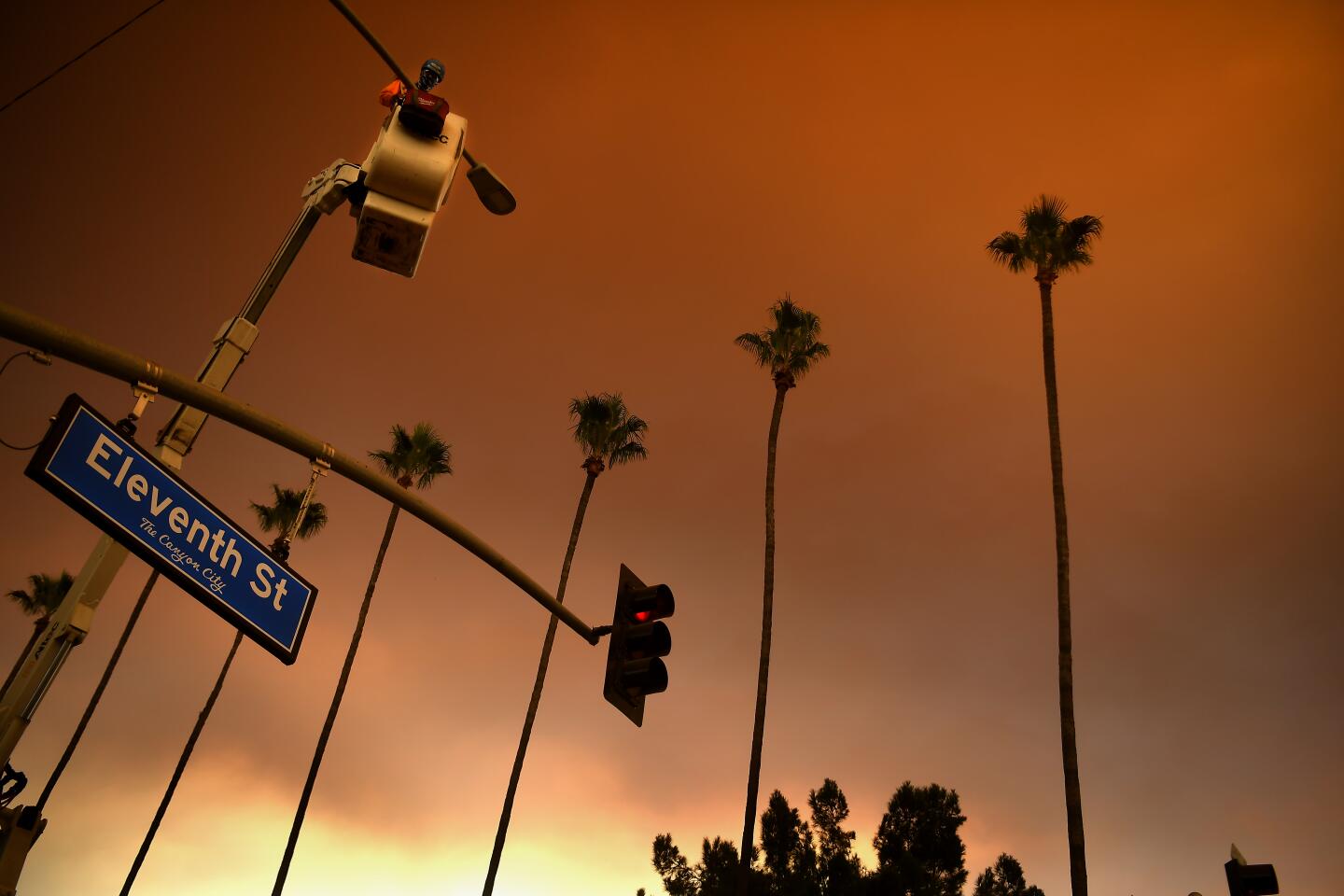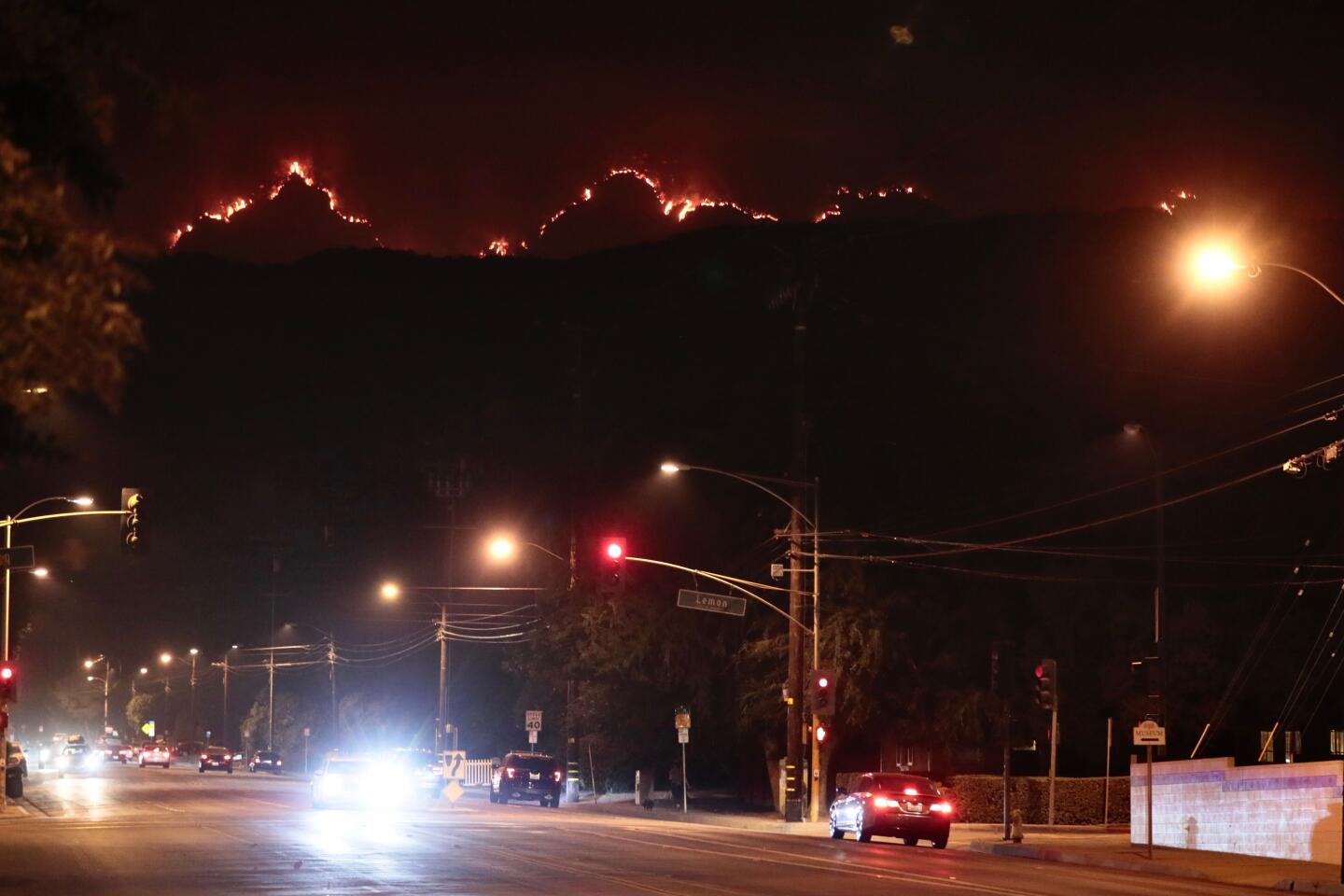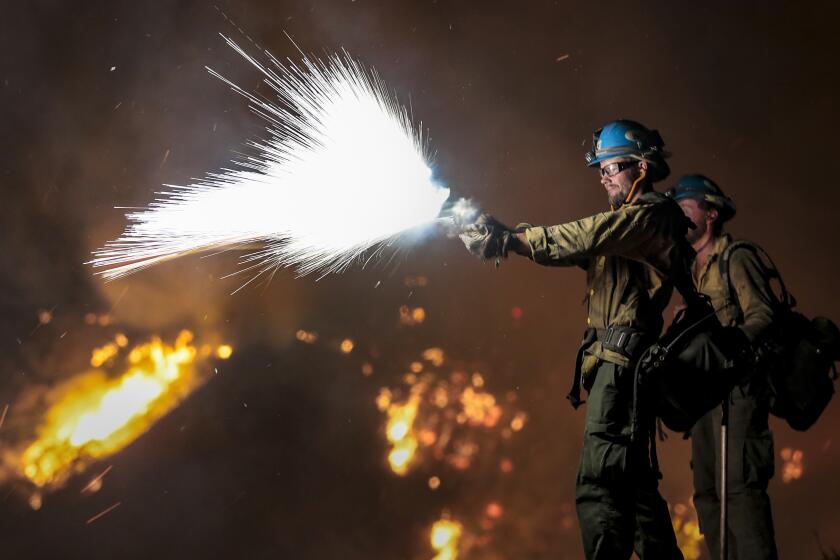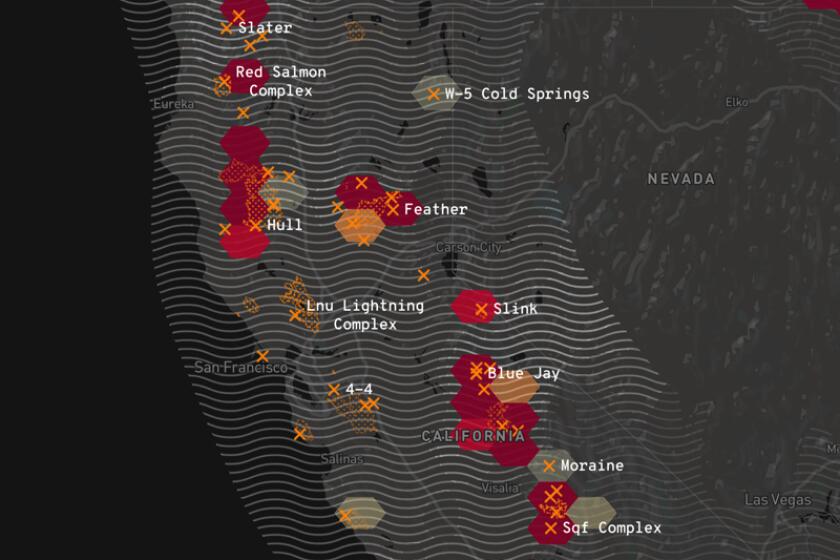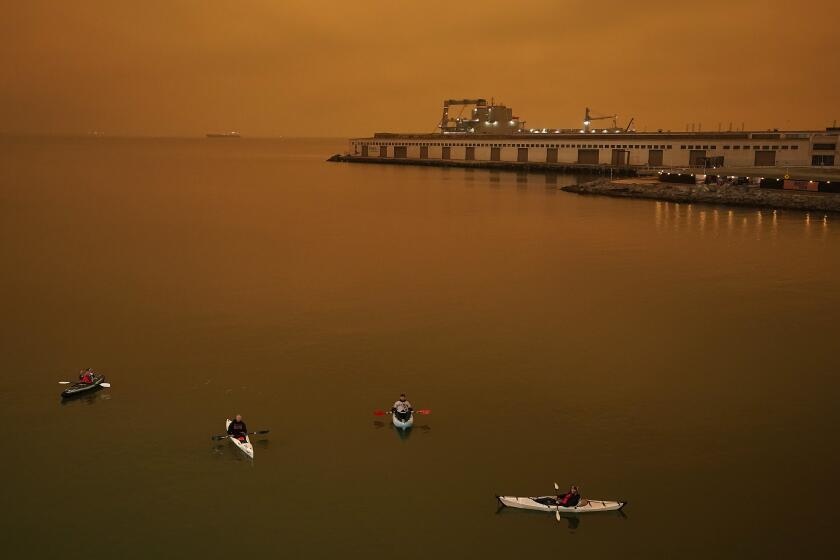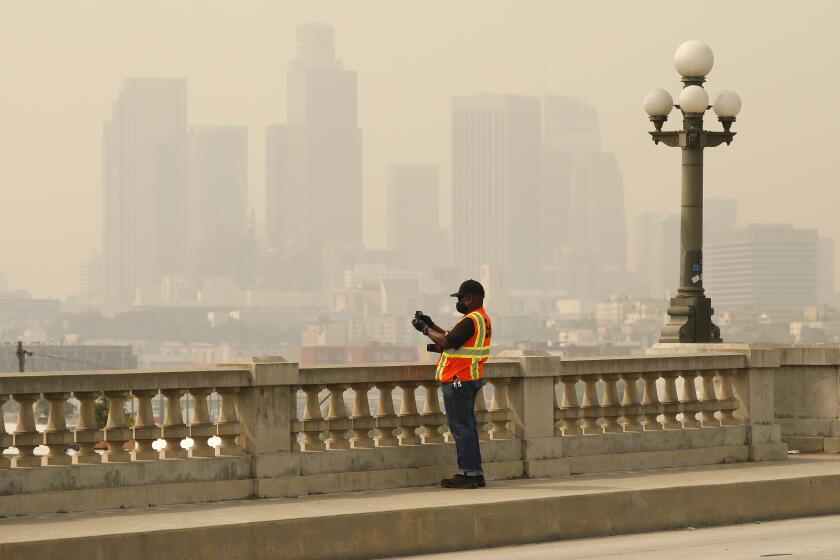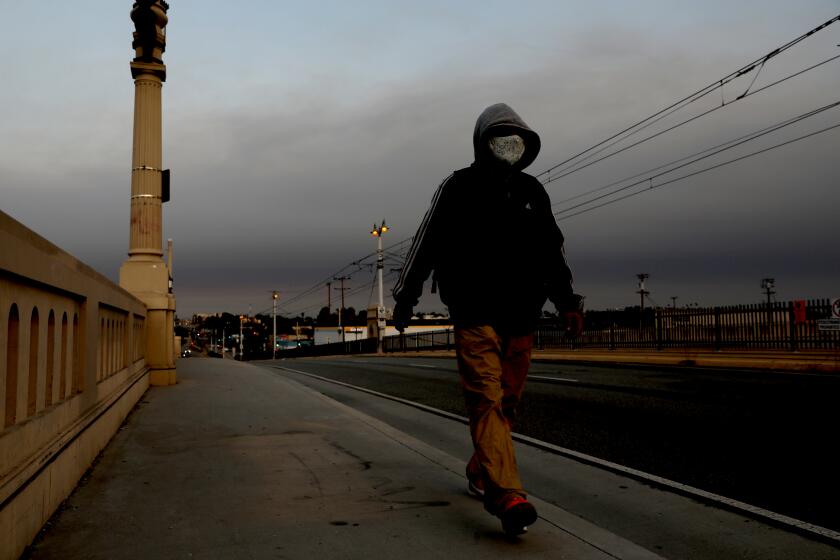Bobcat fire within 500 feet of famed Mt. Wilson Observatory as firefighters mount a defense
After crossing containment lines overnight, the Bobcat fire moved within striking distance of the Mt. Wilson Observatory, the U.S. Forest Service said Tuesday, with firefighters mounting an aggressive defense from the air and on the ground.
The fire continued to push in multiple directions Tuesday, with firefighters stationed at the observatory ready to do battle and multiple aircraft making water drops through the day. The observatory is one of the crown jewels of astronomy, and officials vowed to save the historic complex.
Officials at the 116-year-old observatory tweeted Monday night that the fire was “knocking on our door,” noting that all observatory personnel had been evacuated.
But shortly after noon Tuesday, forest officials tweeted the blaze was less than 500 feet from the observatory. Fire crews “are in place ready to receive the fire,” officials said, noting that strategic firing was taking place to the south, where air operations were strengthening bulldozer lines.
“They are in a firefight right now, because it is so close,” L.A. County Fire Capt. David Dantic said of crews positioned at Mt. Wilson.
Sign up for Essential California
The most important California stories and recommendations in your inbox every morning.
You may occasionally receive promotional content from the Los Angeles Times.
In addition to the observatory’s iconic structures, there are several communications towers atop Mt. Wilson that are threatened by the blaze.
“There’s major infrastructure for radio, television and cell towers up there,” Dantic said, “so there might be possible disruptions.”
Progress on the fire has been slow. After hovering at 6% containment for several days, the blaze, which started Sept. 6 and grew to more than 41,000 acres, is now only 3% contained.
“It’s a bigger area now,” Dantic said Tuesday morning. “Before, we had 6% containment when it was about 30,000 acres, but now the fire has gotten bigger. It’s a bigger footprint. That’s why the containment is down.”
Officials say the fire’s power lies in two factors: location and an inadequate supply of firefighters. But climate experts warn there’s more at play.
Mt. Wilson is a major site in the development of astronomy. The observatory was founded by George Ellery Hale in 1904, and its first telescopes — weighing hundreds of pounds each — were transported in pieces up the nine-mile Mt. Wilson toll road on the backs of burros. Now the observatory lets visitors view space through its 60-inch telescope, which has been in place since 1908.
When the 100-inch Hooker telescope gathered its first light on Nov. 1, 1917, it overtook its 60-inch neighbor and became the largest telescope in the world — a position it held for more than three decades.
Other observatories — in the high plains of Chile, in orbit around the Earth — have rendered Mt. Wilson obsolete, but the campus is still a destination for astronomers and stargazers, who for decades have been drawn by its famed “seeing,” a shared term of appreciation for the quality of light that defines Los Angeles.
Fears of a significant spread of the Bobcat fire dissipated as Santa Ana winds failed to materialize, but foothill communities remain on high alert.
The famed 100-inch and 60-inch telescopes remain destinations for tour groups and the site a venue for concerts. A number of universities, however, maintain smaller and private telescopes at Mt. Wilson, including Georgia State University, which manages the CHARA array.
Completed in 2004, CHARA — Center for High Angular Resolution Astronomy — is an optical interferometer, six telescopes positioned across the campus whose images are coordinated and digitized by computer, giving astronomers details and precise information about star systems thousands of light years away.
The Bobcat fire is approaching the Mt. Wilson Observatory from its most vulnerable front: the steep eastern slopes that rise precipitously from canyons cut by creeks flowing into Big Santa Anita Canyon beside Chantry Flat. The terrain cannot be defended by cutting a fire break, leaving airdrops and backfires as the only strategies.
“If the fire does arrive, I suspect it will come first hit the ground near Echo Point,” said Robert Anderson, a docent with the Mount Wilson Institute, a nonprofit that operates and maintains the historic campus. “The terrain allows no stopping that without the air support.”
Anderson is most concerned about the nearly 100-year-old dormitory, known as the Monastery, where astronomers would sleep during the day before working the night shift at the observatories.
“The Monastery is perched on a ridge, a finger of granite, that is exposed on three sides with steep walls,” he said. “That whole ridge down to the Monastery could easily to be lost without fire suppressant on it. The home of the 20th century’s most celebrated astronomers is on the line.”
Additional personnel have been added to the fire crew, which has been stymied by the aggressive, fuel-driven blaze for days, but the fire crossed the contingency line and was burning along the east side of Little Santa Anita Canyon — the closest it had been to the observatory and threatened communities, Dantic said.
“We were in the process of making a containment line around the whole fire, but unfortunately, with the steep terrain and the fuel there, the fire got over a contingency line that we were trying to make,” he said.
Contingency and containment lines are barriers made by bulldozers and hand crews that help reduce fire fuel, but they’re not foolproof.
“When flame lengths get so big,” Dantic said, “there’s always the possibility of an ember starting another fire outside of the containment line.”
In the forest’s Big Santa Anita Canyon, officials said they feared 80 historic cabins, along with the 1893-built Sturtevant Camp, might have been burned as flames swept through the area Sunday and Monday.
“These are historic buildings made of wood and rock and preserved as such under Forest Service rules,” said Ben Fitzsimmons, president of Big Santa Anita Canyon Permittees Assn. “It is unlikely that this 100-year-old community has survived unscathed.”
Fitzsimmons said he didn’t know the extent of damage in the area but mourned the possibility that many of the historic structures “may no longer exist.”
The cabins, built between 1907 and 1936, are not typical real estate. Owners are issued a “special use permit” to lease the land from the U.S. Forest Service, according to the group’s website. Cabins can’t be purchased using a mortgage, and owners can’t use them as their primary place of residence.
The result, Fitzsimmons said, is a small, close-knit community of people who often spend every weekend together — people who “gather to work on each other’s cabins and socialize together, bonded by our shared experience and love for this unique place that has been a community since the early 1900s.”
Dantic, the L.A. County fire captain, couldn’t confirm whether the fire had reached the Big Santa Anita cabins, but community members braced for bad news.
The skies around the Bay Area and other parts of Northern California took on an eerie glow as smoke from several fires enveloped the region.
“We think we lost most of it,” said Deb Burgess, a cabin owner.
Burgess was doubtful that the Forest Service would allow any burned cabins to be rebuilt, noting that she was previously told that structures more than 50% destroyed could not be rebuilt. Even small work on the cabins must follow strict guidelines about materials, size and other historic characteristics.
As the fire continues to move toward foothill neighborhoods, evacuation orders for residents north of Elkins Avenue and east of Santa Anita Avenue in Arcadia and Sierra Madre remain in place, as do evacuation warnings for residents north of Foothill Boulevard.
Bad air caused by the Bobcat fire and the El Dorado fire in San Bernardino County also continues to be a problem. Three COVID-19 testing sites in L.A. County will be closed Tuesday because of smoke, and a smoke advisory from the South Coast Air Quality Management District will remain in effect throughout the day.
Plumes from deadly, record-breaking fires are being carried in the jet stream across the globe, the National Weather Service reports.
Air quality readings in Los Angeles remain in the 150-200 range, which is considered unhealthful by the Environmental Protection Agency.
“There has been a strong smell of smoke for a few days now, and it definitely feels highly unhealthy to be outside right now,” said 10-year West Hollywood resident Pascal Guyon.
“L.A. has, on average, already had a higher level of air pollution than lots of other major cities,” Guyon said. “Getting too often to worrisome levels of air pollution would definitely get me to move out of this city.”
Angelenos eager to get outside may be wondering how much they can push the limits when it comes to air quality. EPA officials said it’s important to rely on official readings, but also to listen to your body.
“It’s about how you feel as a person because we all react differently to wildfire smoke,” said Meredith Kurpius, an air manager from EPA’s Region 9 Office. “Perhaps you go outside when it’s ‘orange’ and you feel symptomatic. ... You would want to curtail your exertion and your outdoor activity at that time.”
But EPA experts also said people should start taking precautions once readings passed 150, and noted that less strenuous activities, such as walking instead of running, could help reduce the risk of heavier breathing, which leads to sucking in more unhealthful air.
The air around Southern California feels like smoke soup because of wildfires. What does that mean for your health and daily routines?
“On some level, it’s a personal choice,” EPA environmental scientist Kathleen Stewart said. “But once you’re in the ‘red’ category, especially if you’re making a choice for kids, you would want to know that you are exposing them to a level that is not necessarily healthy for them.”
Some improvement to the air quality in areas farther away from the fire is expected Tuesday, thanks to south winds, but smoke will likely be trapped in valleys and basins into the night.
The continuation of southerly winds Wednesday should also help to improve conditions, the Forest Service said, although “communities north of the fires are not expected to see improvement.”
More to Read
Sign up for Essential California
The most important California stories and recommendations in your inbox every morning.
You may occasionally receive promotional content from the Los Angeles Times.
